How Bill Gates and Partners Used Their Clout To Control the Global COVID Response — With Little Oversight
When Covid-19 struck, the governments of the world weren’t prepared.
From America to Europe to Asia, they veered from minimizing the threat to closing their borders in ill-fated attempts to quell a viral spread that soon enveloped the world. While the most powerful nations looked inward, four non-governmental global health organizations began making plans for a life-or-death struggle against a virus that would know no boundaries.
What followed was a steady, almost inexorable shift in power from the overwhelmed governments to a group of non-governmental organizations, according to a seven-month investigation by POLITICO journalists based in the U.S. and Europe and the German newspaper WELT. Armed with expertise, bolstered by contacts at the highest levels of Western nations and empowered by well-grooved relationships with drug makers, the four organizations took on roles often played by governments — but without the accountability of governments.
While nations were still debating the seriousness of the pandemic, the groups identified potential vaccine makers and targeted investments in the development of tests, treatments and shots. And they used their clout with the World Health Organization to help create an ambitious worldwide distribution plan for the dissemination of those Covid tools to needy nations, though it would ultimately fail to live up to its original promises.
The four organizations had worked together in the past, and three of them shared a common history. The largest and most powerful was the Bill & Melinda Gates Foundation, one of the largest philanthropies in the world. Then there was Gavi, the global vaccine organization that Gates helped to found to inoculate people in low-income nations, and the Wellcome Trust, a British research foundation with a multibillion dollar endowment that had worked with the Gates Foundation in previous years. Finally, there was the Coalition for Epidemic Preparedness Innovations, or CEPI, the international vaccine research and development group that Gates and Wellcome both helped to create in 2017.
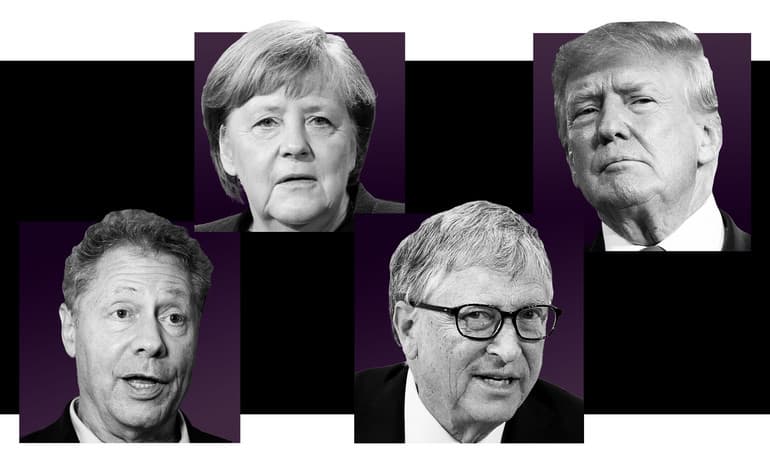
(Left to right) Gavi CEO Seth Berkley, former German Chancellor Angela Merkel, Gates Foundation Co-founder Bill Gates, and former President Donald Trump. | Getty Images and AP Photos
KEY TAKEAWAYS
1 The four organizations have spent almost $10 billion on Covid since 2020 – the same amount as the leading U.S. agency tasked with fighting Covid abroad.
2 The organizations collectively gave $1.4 billion to the World Health Organization, where they helped create a critical initiative to distribute Covid-19 tools. That program failed to achieve its original benchmarks.
3 The organizations’ leaders had unprecedented access to the highest levels of governments, spending at least $8.3 million to lobby lawmakers and officials in the U.S. and Europe.
4 Officials from the U.S., EU and representatives from the WHO rotated through these four organizations as employees, helping them solidify their political and financial connections in Washington and Brussels.
5 The leaders of the four organizations pledged to bridge the equity gap. However, during the worst waves of the pandemic, low-income countries were left without life-saving vaccines.
6 Leaders of three of the four organizations maintained that lifting intellectual property protections was not needed to increase vaccine supplies – which activists believed would have helped save lives.
FOLLOW THE MONEY | METHODOLOGY
Civil society organizations active in poorer nations, including Doctors Without Borders, expressed discomfort with the notion that Western-dominated groups, staffed by elite teams of experts, would be helping guide life-and-death decisions affecting people in poorer nations. Those tensions only increased when the Gates Foundation opposed efforts to waive intellectual property rights, a move that critics saw as protecting the interests of pharmaceutical giants over people living poorer nations.
“What makes Bill Gates qualified to be giving advice and advising the U.S. government on where they should be putting the tremendous resources?” asked Kate Elder, senior vaccines policy adviser for the Doctors Without Borders’ Access Campaign.
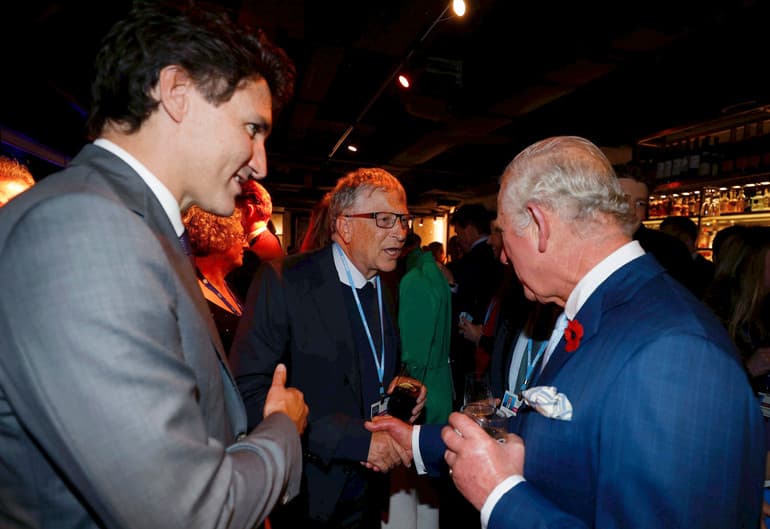
Bill Gates (center), shown above with Britain's Prince Charles (right) and Canada's Prime Minister Justin Trudeau (left) in November 2021, co-founded one of the largest philanthropies in the world. | Pool Photo by Phil Noble
Soon, however, governments in the United States and Europe were offering their own crucial support to the four groups. The organizations spent at least $8.3 million lobbying the U.S. and E.U., according to an analysis of lobbying disclosures. When, this past spring, the leaders of CEPI sought to replenish the group’s coffers, it spent $50,000 in part to advocate for $200 million in yearly funding from the U.S. government, according to filings and interviews with Capitol Hill staff.
The overtures worked. While President Joe Biden’s efforts to obtain an additional $5 billion in funding for the administration’s international work combatting the virus were floundering in Congress, he still managed to slip $500 million for CEPI into his budget proposal — $100 million a year for five years.
The money, which has yet to be approved, would help what most global health experts agree is an important cause, not only in humanitarian terms but in helping prevent poorer nations from becoming breeding grounds for new variants. And most believe that the Gates Foundation and the other groups deserve credit not only for their work to help save lives but for being almost the only game in town with sufficient scope to fight a pandemic.
But the groups’ extensive politicking and financial might in the U.S. and Europe helped to enable them to direct the international response to the most important health event of the past century at a time when governments were caught flat-footed, according to the investigation.
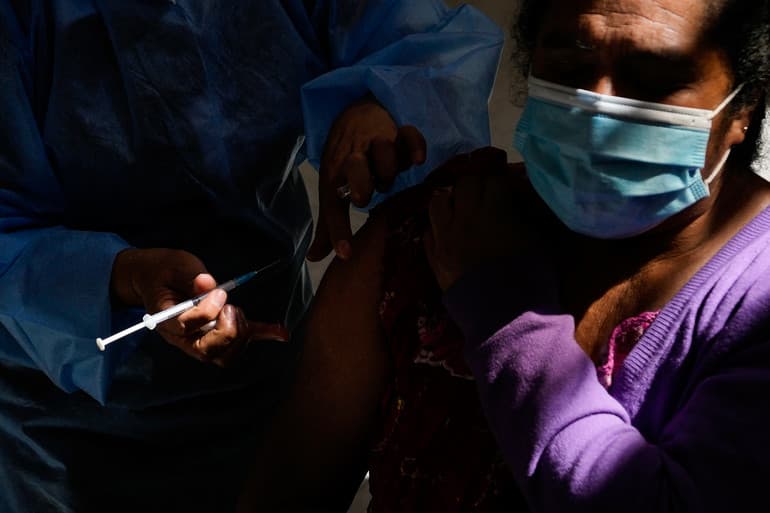
Many people believe that the Gates Foundation and the other groups deserve credit not only for their work to help save lives but for being almost the only game in town with sufficient scope to fight a pandemic. | Moises Castillo/AP Photo
The investigation, which relied on more than four dozen interviews with U.S. and European officials and global health specialists, charted the step-by-step journey through which much of the international response to the Covid pandemic passed from governments to a privately overseen global constituency of non-governmental experts. It also detailed the significant financial and political connections that enabled them to achieve such clout at the highest levels of the U.S. government, the European Commission and the WHO.
The officials who spoke to POLITICO and WELT hail from the top tiers of the governments in the U.S. and in Europe, including in the health agencies. They were granted anonymity to speak candidly about how their respective administrations approached the international response to Covid and what missteps occurred during the course of their tenure. Many of them dealt directly with representatives of the four global health agencies, some on a daily basis.
POLITICO and WELT examined meeting minutes as well as thousands of pages of financial disclosures and tax documents, which revealed that the groups have spent nearly $10 billion since 2020 — the same amount as the leading U.S. agency charged with fighting Covid abroad. It is one of the first comprehensive accountings of expenditures by global health organizations on the global fight against the pandemic.
Now, critics are raising significant questions about the equity and effectiveness of the group’s response to the pandemic — and the serious limitations of outsourcing the pandemic response to unelected, privately-funded groups.
“I think we should be deeply concerned,” said Lawrence Gostin, a Georgetown University professor who specializes in public-health law. “Putting it in a very crass way, money buys influence. And this is the worst kind of influence. Not just because it’s money — although that’s important, because money shouldn’t dictate policy — but also, because it’s preferential access, behind closed doors.”
Gostin said that such power, even if propelled by good intentions and expertise, is “anti-democratic, because it’s extraordinarily non-transparent, and opaque” and “leaves behind ordinary people, communities and civil society.”
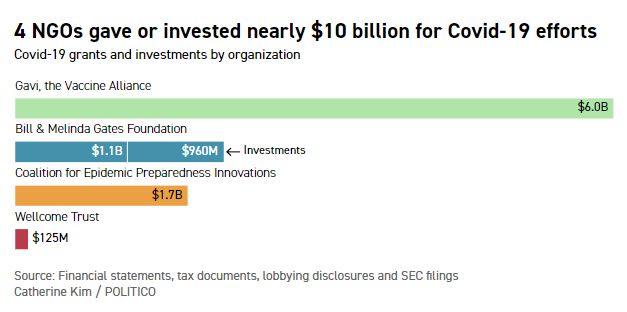
While dozens of global health organizations participated in the world’s response to Covid, the POLITICO and WELT investigation focused on these four organizations because of their connections to one another — both Gavi and CEPI received seed funding from the Bill & Melinda Gates Foundation — and because they together played a critical role in advising governments and the WHO.
The WHO was crucial to the groups’ rise to power. All had longstanding ties to the global health body. The boards of both CEPI and Gavi have a specially designated WHO representative. There is also a revolving door between employment in the groups and work for the WHO: Former WHO employees now work at the Gates Foundation and CEPI; some, such as Chris Wolff, the deputy director of country partnerships at the Gates Foundation, occupy important positions.
Much of the groups’ clout with the WHO stems simply from money. Since the start of the pandemic in 2020, the Gates Foundation, Gavi, and the Wellcome Trust have donated collectively more than $1.4 billion to the WHO — a significantly greater amount than most other official member states, including the United States and the European Commission, according to data provided by the WHO.
“You have to remember that when you’re dealing with the Gates Foundation, it’s almost like you’re dealing with another major country in terms of their donations to these global health organizations,” a former senior U.S. health official said.
Working closely with the WHO, the four groups played a central role in creating an initiative known as the Access to Covid-19 Tools Accelerator, or ACT-A, that focused on securing and delivering tests, treatments and vaccine doses to low- and middle-income countries across the world. COVAX — a special consortium operated by Gavi, CEPI and UNICEF — is the vaccine pillar of the ACT-A initiative.
But ACT-A missed its delivery goals for 2021 on all three fronts — for testing, vaccine distribution and treatments, according to an independent review by Dalberg Global Development Advisors, a policy advisory firm based in New York.
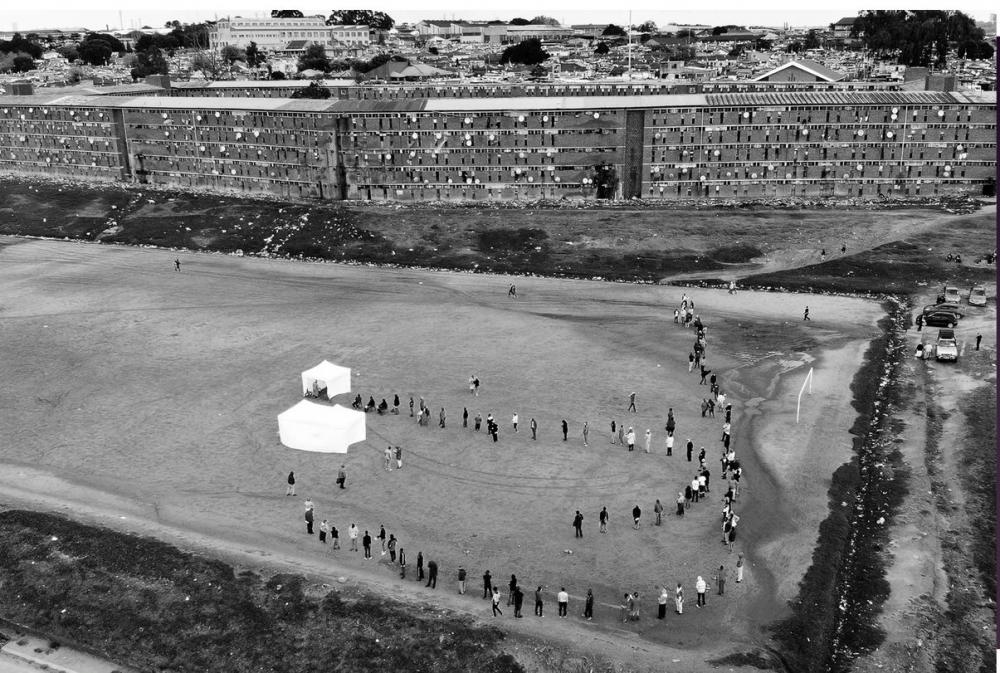
The ACT-A diagnostics team set a target of making 500 million tests accessible to low-and middle-income countries by the middle of 2021. It procured just 84 million tests by June 2021, only 16 percent of its target, according to the report. The therapeutics team originally set a goal of delivering 245 million treatments to low- and middle-income countries by 2021 but later changed the target to 100 million new treatments by the end of 2021. As of June of that year, the therapeutics team had allocated only about 1.8 million treatments.
COVAX set the aim of delivering 2 billion vaccine doses by the end of 2021. By September of that year, it had only delivered 319 million doses.
Although COVAX significantly accelerated the delivery of doses later in 2021 and in 2022, governments have struggled to get shots into arms. As of August 2022, only about 20 percent of Africans were vaccinated — a dangerously low percentage — according to the Africa CDC.
The leaders of the groups say that they were unable to meet their goals largely because wealthy, Western governments were slow to step up and make available the huge tranches of vaccine and therapeutics that were needed to protect the world. The groups say they provided a crucial voice for the suffering and needs of poorer nations, without which the progress may have been far slower.
“The Gates Foundation focused on supporting a global response that would ensure low- and middle-income countries had affordable, equitable access to the best data and tools available to tackle the crisis,” Mark Suzman, CEO of the Gates Foundation, said in a statement. “In some areas we saw successes. On the most critical issue of equitable vaccine access, the world as a whole failed as high-income countries initially monopolized available supply.” The foundation declined to make Gates available for comment.
On the struggle to deliver vaccine doses to low- and middle-income countries on time, Seth Berkley, the CEO of Gavi, said in an interview that the organization actually met one of its original targets of distributing 950 million doses by the end of 2021 to low-income countries, even though it failed to deliver on one of its original promises to distribute 2 billion doses. (COVAX delivered the 950 million doses by January 2022.)
“It’s very easy to sit there outside and to criticize what we’re doing. What we need to do is to be evaluated fairly based upon the actions we took at the time with the knowledge we had at the time,” Berkley said.
A spokesperson for CEPI put it this way: “While there is much that we can improve upon, it would be inaccurate to apportion all the blame for the failures of the global response to the very organizations that did more than anyone else to try and solve the problems of vaccine supply and inequity.”
”The challenge we faced was the need to bake in access to vaccines for poor countries right at the point when companies were able to sell promising product to the highest bidder,” the spokesperson said.
Jeremy Farrar, the Wellcome Trust director, struck a similar note. “Comprehensive pandemic preparedness and response requires the sort of funding and international cooperation that only governments can muster,” he said.
Farrar, however, defended the ACT-A partnership as “the best mechanism we have for delivering lifesaving Covid-19 tools across the world.”
“Before ACT-A was set up, there was no formal mechanism in place to coordinate and accelerate the development, production and equitable access to Covid-19 interventions globally,” he said. “While ACT-A may not be perfect … the global response would have been poorer and far more fragmented without it.”
The POLITICO and WELT investigation found, however, that ACT-A’s structure diminished accountability. ACT-A representatives set funding priorities and campaigned for donations. But the money — $23 billion in total — went directly to the entities involved in the initiative, such as Gavi and CEPI. Although ACT-A’s website keeps track of how much money was raised, it is nearly impossible to tell exactly where all of it went.
Based on each organization’s individual Covid database, it is not possible to delineate exactly how the groups spent the money raised through ACT-A. It is also difficult to determine in the organization’s grants and investment data how much they donated specifically for ACT-A programming. For example, the organizations do not use “ACT-A” or similar terminology in their descriptions of their grants and investments.
“In theory, I think that was a great idea,” said Gayle Smith, who led the U.S. State Department’s global Covid-19 response last year, referring to ACT-A. But she questioned its accountability.
“In practice … there was no single director,” Smith said. “Who’s the big boss of this whole enterprise? In a global emergency like this, we need to be able to get the countermeasures to everyone everywhere as quickly as possible.”
Bruce Aylward, who coordinates the work of the ACT-Accelerator at the WHO, said ACT-A was purposely set up with a decentralized structure in order to cut down on bureaucracy. He said that each agency was in charge of their own accounting and solidifying agreements directly with donors.
Smith and others closely involved in the global Covid fight say there should have been a stronger hand at the tiller.
When vaccine doses started flowing into COVAX, many poor countries and provinces were ill-equipped to handle them. And during the long delays, many potential beneficiaries lost faith in the global health system.
“I think that if we had had the vaccine earlier the coverage would have been much, much, much better,” said Stephen Bordotsiah, the municipal director of health services in the Bolgatanga region of Ghana, which received significant doses from COVAX.
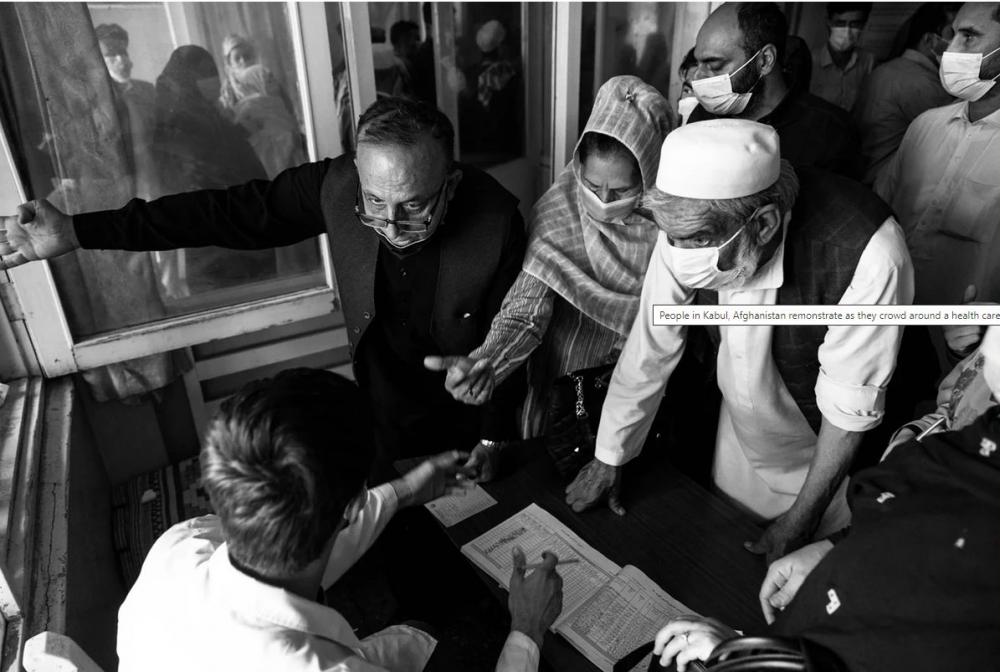
During the long delays in the rollout of the Covid vaccines, many potential beneficiaries lost faith in the global health system. | Paula Bronstein/Getty Images
While ACT-A devoted most of its time and resources to securing doses, little money went to improving health systems on the ground. Of the $23 billion that ACT-A and its receiving agencies — including Gavi and CEPI — raised, only $2.2 billion went to the strengthening of health systems, according to the WHO initiative’s own funding tracker.
Aylward blamed any of ACT-A’s deficiencies on “factors that were beyond the control of the accelerator,” he said, including a lack of government financing for distribution of Covid tools to low-income countries. “Every politician stood up there and said all the right things. They wanted to do the right things,” Aylward said. “We got to create the enabling environment to let them do that.”
Now, the four groups are spending millions of dollars to lobby the U.S. and EU to embrace their priorities for the next pandemic, some of which include strengthening local health systems. Other initiatives involve investing more money in research and development, hoping to create next-generation vaccines and expanding surveillance networks across the globe.
Meanwhile, many global health specialists question whether the groups are capable of performing the rigorous post-mortems necessary to build a stronger global response system for the future.
“No one’s actually holding these actors to account,” said Sophie Harman, professor of international politics at Queen Mary University of London. “And they’re the ones that are really shaping our ability to respond to pandemics.”
Each of the four organizations said they are doing at least some internal reflection of their Covid work.
CEPI is wrapping up an assessment of its work over the past five years, including on Covid, and plans to publish it in full in September. Representatives for the Gates Foundation and Wellcome said their respective organizations have completed internal reviews, though no formal publication of those findings exist on the groups’ websites. Gavi has also commissioned an outside firm to conduct a review of COVAX and plans to publish its findings. It’s unclear when that report will be made public. The group published a general document about lessons learned from Covid on its website on Wednesday.
Representatives of ACT-A said the consortium reviewed its Covid work following the publishing of the Dalberg report in 2021. It addressed its recommendations and said how it would improve in a strategic planning document published on its website in October 2021. It is also tracking that work internally, a spokesperson for ACT-A said.
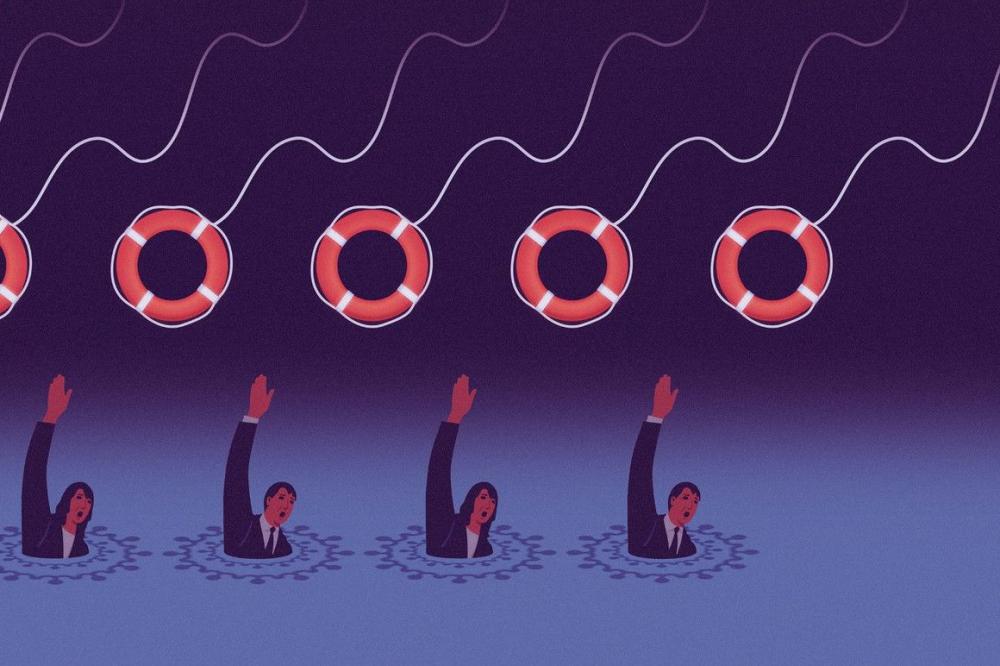
CHAPTER 1
Filling a Void
Just days before New Year’s Eve 2019, a man in France checked himself into a hospital, complaining of a fever and shortness of breath. Doctors didn’t know at the time — and wouldn’t realize until months later — that the man had likely developed one of the first cases of Covid-19.
The virus had been circulating in China in the weeks preceding the man’s hospitalization, but the Beijing government refused to share details about the newly dubbed SARS-CoV-2. It wasn’t until New Year’s Eve that the WHO was first notified about the cases of “viral pneumonia,” which was spreading at an alarming pace.
Top officials across the U.S. and Europe watched the news from afar, viewing the virus as a problem for Beijing — not the rest of the world. Top Trump administration officials, including the president, brushed off warnings. In Europe, a risk assessment from the European Center for Disease Control and Prevention on Jan. 9 stated “the likelihood of introduction to the EU is considered to be low, but cannot be excluded.”
Then, on Jan. 18, the CDC confirmed the first U.S. case of Covid.
Public health officials in the U.S. and Europe scrambled to figure out how to respond, frantically attempting to close borders and isolate people who tested positive.
The faltering response shouldn’t have been a surprise: In 2019, the Trump administration concluded an exercise in which top health officials determined the U.S. was unprepared to fight a global pandemic. Three years earlier, in 2016, the United Kingdom had carried out a simulation exercise for a hypothetical influenza pandemic, which showed that its health system would become overwhelmed in such an event.
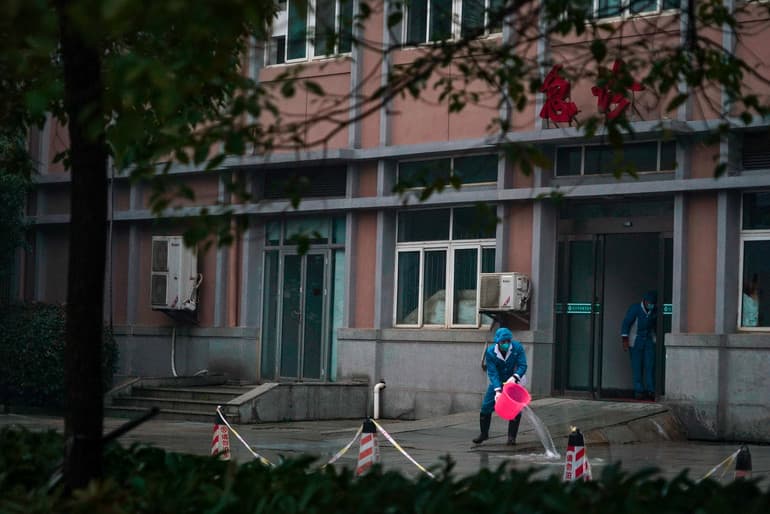
Top officials across the U.S. and Europe viewed the virus, which originated in Wuhan, China, shown above in January 2020, as a problem for the Chinese government — not the rest of the world. | Dake Kang/AP Photo
Neither the U.S. nor Europe had done much in the interim to boost their preparedness — though they were considered by the global health community as perhaps the most capable of all regions of the world to handle a pandemic. But there were other players — non-governmental organizations — who were far better prepared, having dedicated themselves to fighting Zika, Ebola and similar outbreaks that crossed national boundaries.
The largest was the Bill & Melinda Gates Foundation, whose vast influence is also the connective thread between the groups.
Bill Gates and Melinda French Gates started the foundation in 2000, using money from Bill Gates’ Microsoft days to kickstart the philanthropy. In 2006, Warren Buffett, the CEO of Berkshire Hathaway, a large holding company, announced that he would donate most of his fortune to the foundation.
The foundation draws on a $70 billion endowment to grant billions of dollars every year to organizations working on some of the world’s toughest health problems. Bill Gates recently pledged that he would give virtually all of his fortune to the foundation and that the organization would increase its spending from nearly $6 billion annually to about $9 billion by 2026.
One of the largest philanthropies in the world, the Gates Foundation helped create both Gavi and CEPI and has representatives on both of their boards.
Gavi was founded in 1999 with $750 million from the Gates Foundation to strike vaccine deals with pharmaceutical companies for low-income countries. The vast majority of its financing is made up of donations from governments. The organization focuses solely on immunization and its board is made up of multiple representatives from the global south.
CEPI launched in 2017 with the financial backing from the Gates Foundation, the Wellcome Trust, Norway and India, with the mission of funding vaccine research and development. In the last five years, the organization, which is helmed by Richard Hatchett, a former Obama administration official, has become one of the world’s leading nonprofits in vaccine development, garnering donations from powerful, Western governments.
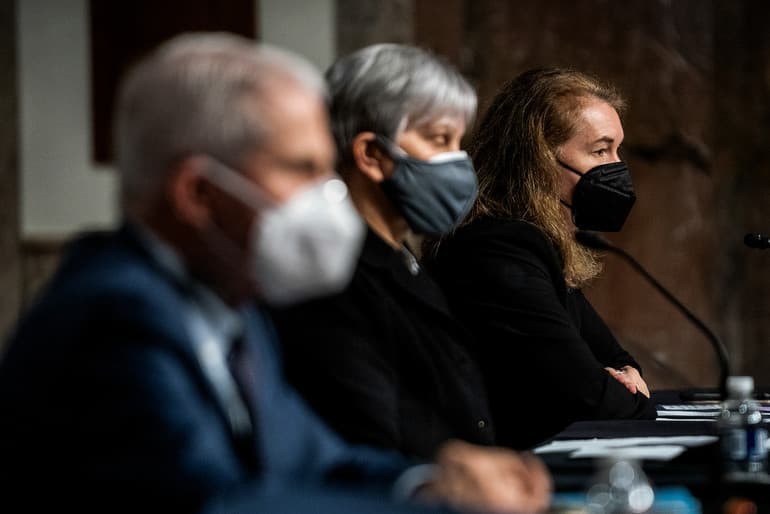
Dawn O’Connell (right), a former CEPI employee, is the leader of one of the most important branches in the Department of Health and Human Services for pandemic preparedness in the U.S. | Pool Photo by Greg Nash
The Wellcome Trust, which was created in the 1930s in the United Kingdom by a founder of what was one of the largest pharmaceutical companies in the world, operates with an endowment of about $38 billion, according to its website. It is one of the largest charitable foundations in the world and dedicates significant funding to biomedical research and scientific data modernization. The director of the trust, infectious disease expert Jeremy Farrar, until recently was an adviser to the British government on health emergencies.
The global health nonprofits moved quickly in 2020 to fill the leadership void left by governments still grappling with their domestic responses, according to lobbying disclosures, meeting minutes and interviews.
Leaders of the Gates Foundation, Gavi, CEPI and Wellcome deployed their lobbying and advocacy networks and used their political connections to push U.S. and European officials to commit billions of dollars to Covid programs the organizations helped envision and lead.
The extent of their access to global decision-makers attests to their central role in helping establish the global Covid response: The groups briefed top officials in the European Commission about investments in tests, treatments, shots and the importance of sharing those products with the rest of the world. In the U.K., the organizations usually met several times a month with ministers to discuss topics such as Covid testing, clinical trials and manufacturing capacity. Some of those meetings included Prime Minister Boris Johnson. Bill Gates and Melinda French Gates — his former wife — spoke directly to then-German Chancellor Angela Merkel about the distribution of Covid vaccine, according to German government documents obtained by POLITICO and WELT.
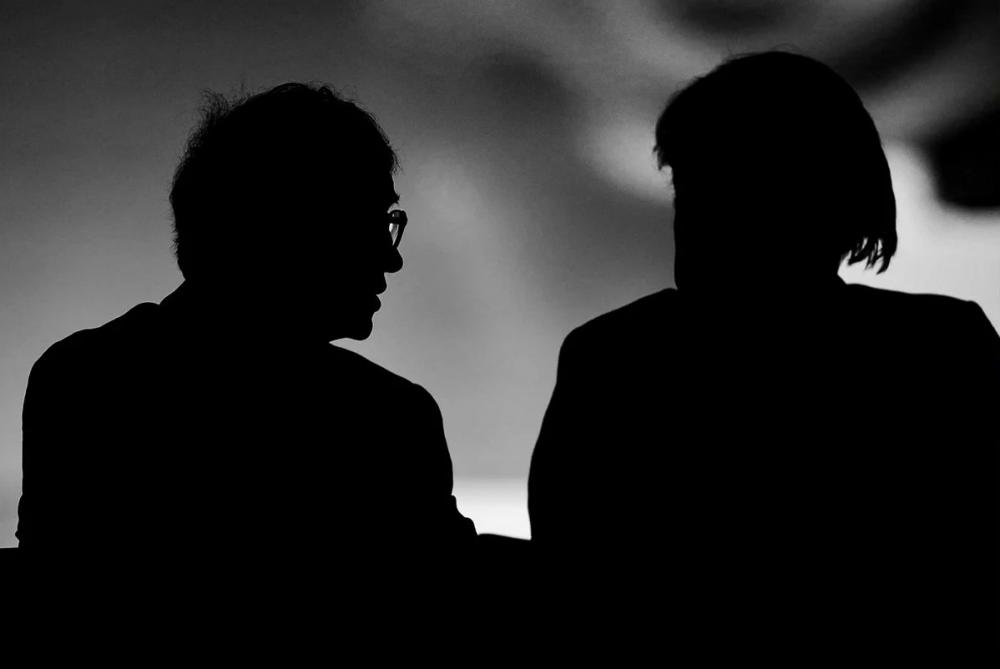
Bill Gates (left), shown above in 2018, spoke directly to then-German Chancellor Angela Merkel (right) about the distribution of Covid vaccines. | Markus Schreiber/AP Photo
Meanwhile, in the U.S., leaders of the organizations were also in contact with senior U.S. health officials. Emails obtained by Republicans on Capitol Hill illustrate the extent to which Farrar, the director of Wellcome, was in touch with officials in some of the highest levels of the U.S. government on a sensitive health and national security issue. The emails, released this year, show Farrar in the early weeks of the pandemic discussing the possibility of Covid having leaked from a lab in China with top U.S. health officials including Anthony Fauci and National Institutes of Health Director Francis Collins.
“We relied heavily on their advice throughout the pandemic, but especially in the early days,” said a former U.S. official about the federal government’s interactions with representatives from the organizations.
But even though the foundation’s expertise was obvious — Bill Gates and Melinda French Gates had made fighting viruses a major part of their life’s work — the fact that crucial decisions were being refracted through American billionaires and the massive network they’d established raised concerns among some officials as well as grassroots activists on the outside.
“These big men of global health and how they … captured the agenda and managed to influence what people are thinking around pandemic preparedness and response – I think that’s really important [to consider],” Harman said. “ a revolving door of where these people are educated, where these people have worked, how they get the jobs that they’re in – it’s all a really close network.”
The foundation’s clout and that of its allies wasn’t merely a function of being the only game in town; it was also the product of concerted lobbying and advocacy work.
“They’re very good lobbyists. The people are very capable and passionate about their goals,” a European Union official said. “They, of course, also come for funds.”
Over the last two years, Gavi and CEPI have spent at least $1.3 million on lobbying aimed at obtaining U.S. and European cash to fund their own enterprises and the causes they supported, according to lobbying records. Wellcome also lobbied in Europe — spending at least $1.1 million — to gain political support for its programs.
Meanwhile, the Gates Foundation in 2019 set up a lobbying firm known as the Gates Policy Initiative, led by Rob Nabors, former White House deputy chief of staff for policy in the Obama administration. There are no lobbying disclosure forms on file for the firm.
A spokesperson for the foundation said U.S. law prohibits private foundations from engaging in lobbying and that the Gates Policy Initiative is a separate organization from the foundation that does not coordinate with it on programmatic activities. In a statement, a spokesperson for the Gates Policy Initiative said the organization is funded through a “direct gift” provided from Bill Gates and Melinda French Gates and that it has not engaged in activities that would require the filing of lobbying disclosure forms.
In the EU and the U.K., from 2020 to early 2022 there were over 100 meetings related to Covid or pandemic preparedness between officials of the four organizations and senior Commission or U.K. officials, according to lobbying records. Leaders of the organizations attended some of the meetings, as did the U.K. prime minister and the head of the European Commission, Ursula von der Leyen. In Germany, CEPI and Gavi sent numerous letters to the German chancellor’s office over a two-year period in an effort to elicit more funding for their respective organizations.
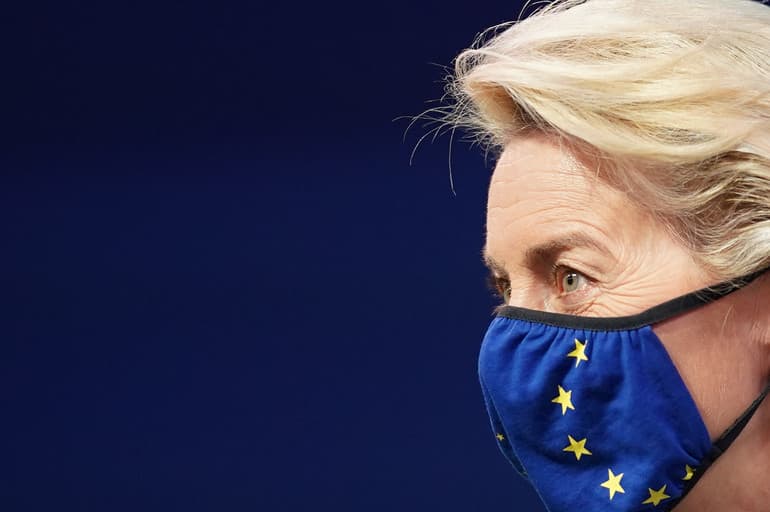
European Commission President Ursula von der Leyen was one of the many leaders who attended meetings related to Covid or pandemic preparedness with officials from the four global health organizations. | Ian Forsyth/Getty Images
All the concerted outreach paid off, both in terms of money and clout.
Since 2020, CEPI and Gavi have raised billions of dollars as a result of their lobbying. Between 2020 and 2021, the European Commission gave CEPI over $100 million, while the U.K. contributed more than $330 million, Germany paid over $430 million and the U.S. gave $8 million. In the case of Gavi, for the period of 2021 to 2025, the U.S. has pledged over $4.8 billion, the U.K. has allocated over $2.6 billion, Germany has promised over $2 billion and the European Commission over $1 billion.
Making plans
From the very first weeks of the Covid crisis, the organizations served as coordinators for the global health community. They convened meetings with key health organizations and made calls to researchers and officials across the globe. They also reached out to pharmaceutical companies to gauge their willingness and ability to quickly scale the production of medical countermeasures should it be required. Bill Gates gave television interviews in the early months of the pandemic, taking on the posture of a world leader.
But throughout the first three months of the pandemic, the four organizations jumped ahead of the governments in charting the global nature of the response. They identified companies to work with to develop medical countermeasures. The Gates Foundation and Wellcome began to invest and announce grants to companies working to produce tests and treatments for Covid, according to the POLITICO and WELT financial analysis.
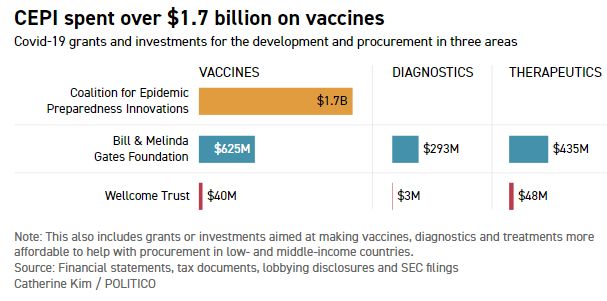
A spokesperson for the foundation said one of the advantages of its grants was the ability to “deliver fast and flexible funding” and to “fill resource gaps,” adding that before the Covid pandemic was even declared, the organization had granted $10 million to the global response.
By the end of January, CEPI had already decided to invest $5 million in four vaccine development projects, according to its board minutes. The Gates Foundation would go on to invest in vaccine development as well by extending grants to, for example, the University of Washington and NYU, and to Oxford University.
Meanwhile, in the recesses of the Trump administration’s health agencies, officials in January 2020 began discussing vaccine development with pharmaceutical companies, but contracts with those entities would not finalize until months later. It would take until April to fully develop Operation Warp Speed —the team that worked in coordination with the Department of Health and Human Services to fast-track the development of the vaccine and to scale its production. In the meantime, the U.S. focused primarily on responding to Covid domestically, dedicating limited resources to fighting the virus abroad.
By contrast, the leaders of the organizations began to develop systems for distributing those tools abroad, particularly to low- and middle-income countries.
“In previous global health crises, the U.S. government really had played that lead role of helping organize the world around getting vaccines and drugs, and other countermeasures to where they’re most needed. But the U.S. under the Trump administration wasn’t playing that role,” said Tom Bollyky, director of the global health program at the Council on Foreign Relations and an adviser to CEPI. “It really was left to organizations like the Bill and Melinda Gates Foundation, Gavi and others, to try to help marshal governments around a plan.”
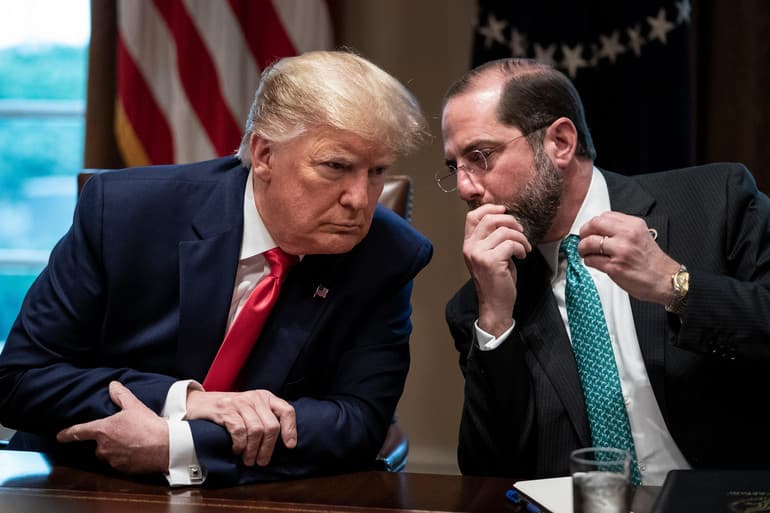
Former Trump officials said Gates and his team frequently met with people in the administration, including Health Secretary Alex Azar (right), about the government’s spending priorities in fighting the pandemic. | Drew Angerer/Getty Images
Paul Mango, former deputy chief of staff for policy at the health department under Trump, confirmed that the U.S. did not start developing a plan for international vaccine distribution until July of 2020 —more than five months after the virus first emerged. But, he said, the U.S. began working as early as February of 2020 to identify potential vaccine candidates, though the administration did not finalize its financial investments in those companies until months later.
“We had to evaluate a number of different characteristics of the company and the vaccine before we invested,” he said in an interview. “We wanted to see if phase one and two of the clinical trials revealed good data. That took a couple of months.”
A seat at the table
Beyond beginning to grant millions of dollars, CEPI and the other organizations set up international consortiums to shapeshift the world’s initial response to the pandemic through the WHO.
While governments are responsible for developing their own domestic responses to infectious disease outbreaks, the WHO acts as a conduit for member states — composed of 194 countries — to receive guidance as well as financial help in investigating, containing and fighting viruses like Covid. The WHO receives billions of dollars annually, operates out of 150 country offices across the globe and employs thousands to work on health issues from child mortality to HIV to nutrition.
Member states vote on policy provisions at the yearly World Health Assembly in Geneva. The Gates Foundation and the other three organizations do not have voting power, but their donations give them an important seat at the table. Wellcome, the Gates Foundation and Gavi have collectively donated $1.4 billion to the WHO since 2020 and about $170 million specifically for Covid-related programs since 2020, according to WHO data.
On a policy level, their clout is even more visible. Until October of last year, Farrar, the CEO of Wellcome, led one of the WHO’s scientific advisory groups that explored research and development priorities on Covid.
“They have very, very powerful influence within multilateral organizations — equal to or above governments,” said another former senior U.S. health official. “When you’re talking about … combined … over a billion dollars, that carries with it a lot of hope and sway.”
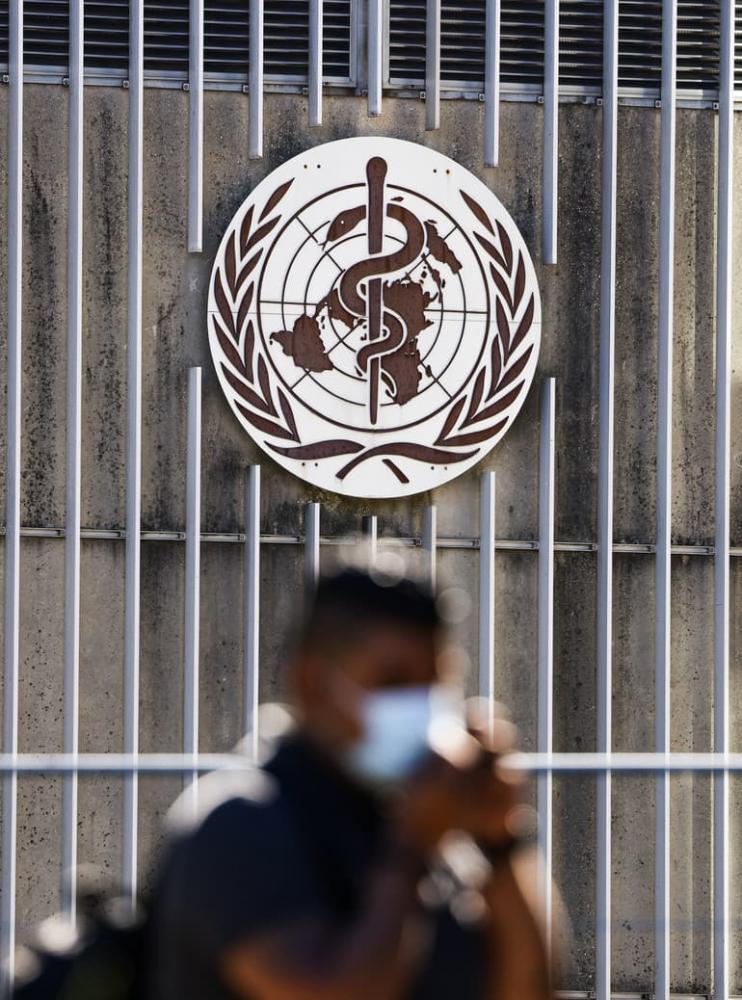
Wellcome, the Gates Foundation and Gavi have collectively donated $1.4 billion to the WHO since 2020. | Sean Gallup/Getty Images
At the end of January, 2020, representatives from the Gates Foundation and Wellcome were a regular presence at meetings with the WHO and top officials from the U.S. about the virus’ spread, Covid sample sharing and vaccine and drug clinical trials, according to meeting minutes. They even helped organize and fund the first truly international meeting at the WHO to lay the groundwork for the world’s response to the virus.
David Vaughn, deputy director of vaccine development at the Gates Foundation, and Josie Golding, the lead of Wellcome’s epidemic responses, hosted a preparatory meeting Feb. 4, 2020, with U.S. officials and members of the WHO Scientific Advisory Group, according to another set of WHO meeting minutes. In the meeting, the organizations’ representatives suggested that potential funders come together to discuss the WHO’s research and development blueprint — a framework for how the international community could respond to the virus.
By the end of the global conference in the second week of February, attendees had agreed on a comprehensive road map for the world’s response to Covid, including how funders would support vaccine, drug and test development. WHO officials called for $675 million to respond to Covid.
The Gates Foundation announced that it would dedicate $100 million to the effort. At a CEPI board meeting, Hatchett said the organization had signed four agreements for Covid vaccine development and that the organization was working closely with the WHO, dispatching two staff members to work on vaccine development.
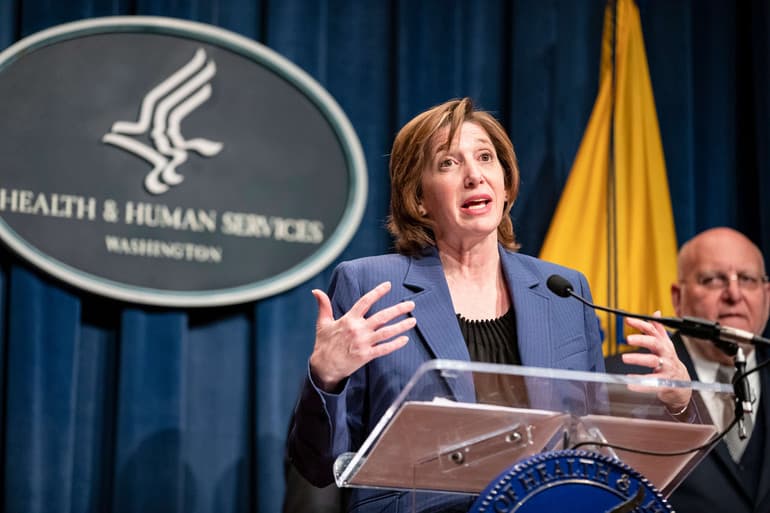
Health official Nancy Messonnier’s public warning in late February forced the Trump White House to recognize the potential threat of Covid-19. | Samuel Corum/Getty Images
All this global planning was occurring at a time when the Trump White House was not acknowledging the Covid threat — before health official Nancy Messonnier’s public warning in late February set off alarm bells.
It would take still longer for national security and health officials to convince the president to take the virus seriously and consider steps to control the spread nationwide.
A dangerous spread
By the middle of February, 2020, Covid had begun spreading to Africa — where each of the organizations, but particularly the Gates Foundation, had worked extensively. Africa’s first recorded case was a 33-year-old man in Egypt, worrying global health officials that a large-scale outbreak would completely overwhelm the continent’s health systems.
The Africa Centres for Disease Control and the WHO moved quickly to send medical supplies and tests to stop the spread of the virus. But it was too late. The global health organization described the outbreak as a worldwide pandemic a month later on March 11. Another month after that, Covid cases topped 10,000 in Africa.
The four global health organizations mobilized quickly to try to prepare low-income countries, including in Africa, for the coming assault of cases, the POLITICO and WELT financial analysis showed. In March, the Gates Foundation granted $47 million to dozens of different organizations, including the CDC Foundation, the WHO and to institutions to help detect Covid and develop monoclonal antibodies. Former CDC director Tom Frieden’s Resolve to Save Lives (formerly known as Vital Strategies) received close to $1 million to help strengthen epidemic preparedness capacity for Covid in the African region.
Despite the spread worldwide, at home the Trump administration downplayed the danger posed by the virus well into March, claiming that the U.S. had contained Covid. And the administration maintained that it would focus on controlling Covid at home, dedicating resources to the American people, rather than spearheading efforts to help fight the virus overseas.
“During the Trump administration, even us talking about doing global work was just constantly shot down,” said one of the former senior U.S. officials. “When USAID got their funds to provide external Covid aid, the response funds were going to Gavi … to do that work on behalf of the United States. It was made very, very clear that the United States would never be sending people — particularly not the military — to other nations to do that type of work.”
The European Commission took a different approach. It pledged €232 million, roughly the same in U.S. dollars, to aid the global Covid response, including €15 million to Africa and the Institute Pasteur of Dakar in Senegal for diagnosis and surveillance efforts, according to the POLITICO and WELT investigation. The Commission also put up $2.6 million specifically for the WHO office in Kenya.
Meanwhile, Hatchett, CEO of CEPI, was in the midst of trying to garner more support for his own organization and its fight to invest in the development of the vaccine. He wrote to Merkel on March 4, requesting Germany to help close its financing gap — $375 million. “Without this investment, CEPI will not be in a position to continue the COVID-19 vaccine development programme,” Hatchett wrote in a letter obtained by the POLITICO and WELT-team. Nine days later, CEPI announced a €140 million funding boost from Germany.
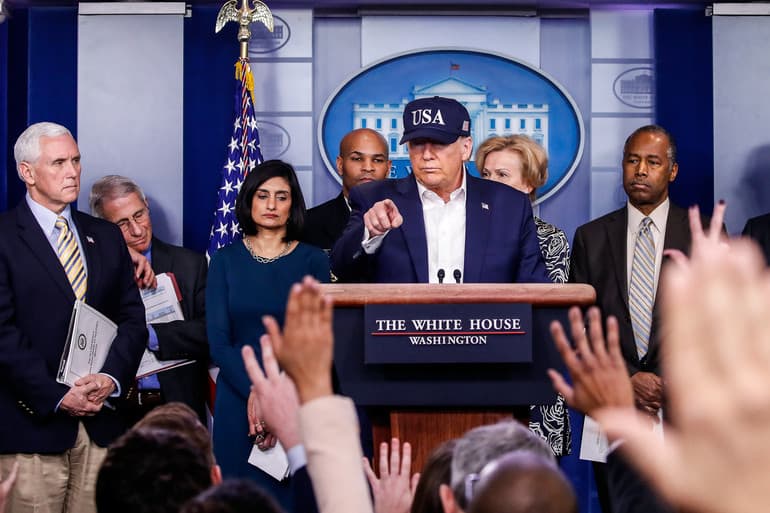
The Trump administration consistently maintained that it would focus on controlling Covid at home, dedicating resources to the American people, rather than spearheading efforts to help fight the virus overseas. | Alex Brandon/AP Photo
At the virtual March 26 G-20 Covid summit, leaders said in a statement that they would commit to donating resources to the WHO, CEPI and Gavi. “We call upon all countries, international organizations, the private sector, philanthropies and individuals to contribute to these efforts,” the statement said.
The U.S. and EU would eventually dedicate hundreds of millions of dollars to aiding the global fight against Covid, but the majority of their contributions to vaccine procurement and distribution would not come for more than a year —until the summer and fall of 2021. Their resistance to sharing doses would delay the global vaccination campaign, denying millions in low-income countries of first doses at a time when people in the U.S. and Europe were receiving their second.
That hesitation left a gap in global health policy.
The four organizations spent significant amounts of money, starting in the spring of 2020, to lobby members of Congress to give the organizations money so they could aid low-income countries, according to lobbying disclosures. In 2020, Gavi and CEPI spent more than $435,000 on lobbying Congress and senior officials in the U.S. Agency for International Development, the White House and the Department of Health and Human Services. CEPI pushed for specific language in legislation that would authorize the U.S. government to support its mission at $200 million a year.
“CEPI and the friends of CEPI … lobbying Congress hard on this issue and have pushed the language into almost every vehicle that looks like it is moving,” a former senior U.S. health official said.
The spokesperson for CEPI confirmed the lobbying activities, saying the organization has “consistently” asked the U.S. government for $200 million annually. “This ask has been supported by several NGOs and civil society groups,” the spokesperson said.
Eventually, in October 2020, the Trump administration, through USAID, pledged $20 million to CEPI. The bulk of the additional U.S. funding pledges for the global fight against Covid, including $4 billion to Gavi, would not come through until 2021.
As a response to the growing gap in international Covid funds and programing, Wellcome, the Gates Foundation and Mastercard in March 2020 created the Covid-19 Therapeutics Accelerator — a collaboration to raise money for Covid treatments — and committed up to $125 million in funding. The accelerator set out to quickly develop and test drugs to fight Covid.
The investment marked one of the first partnerships to launch a program to help fast-track the development of a tool that could help save lives from Covid. It also marked one of the first major collaborations between the organizations and the pharmaceutical industry during the pandemic.
‘Moonshot’
As the winter months of 2020 gave way to spring and millions of people across the globe contracted the virus, the global health organizations began to coordinate and unleash similar investment strategies, playing key roles in identifying which pharmaceutical and scientific firms would be earmarked for funding.
Over the following two years, they would grant hundreds of millions of dollars to dozens of the same organizations. For example, Wellcome and the Gates Foundation gave $452 million to 18 of the same organizations, including several companies producing vaccines, tests and therapeutics, according to the financial analysis.
As the organizations continued to invest in the development of the Covid shots and medicines, they also began to envision programs that would help with their distribution.
At the beginning of April 2020, the Gates Foundation produced papers on programs that could help with equitable distribution of vaccine doses, tests and therapeutics.
The foundation’s papers focused on the development of ACT-A — the Access to Covid-19 Tools Accelerator, originally dubbed a “task force” that aimed to “support the equitable delivery of effective affordable” Covid tools within a short time period, according to draft copies. The initiative, designed with significant input from Gavi and CEPI, was supposed to be the answer to ensuring people in low- and middle-income countries had access to life-saving medicines and vaccines.
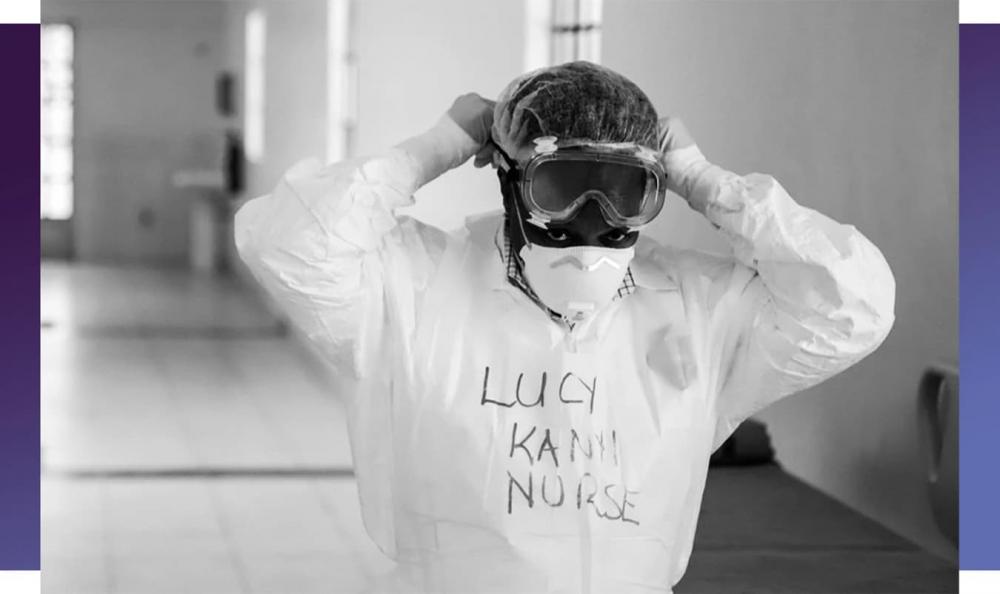
ACT-A was supposed to be the answer to ensuring people in low- and middle-income countries had access to life-saving medicines and vaccines. | Patrick Ngugi/AP Photo
The Gates Foundation, CEPI, Gavi, Wellcome and several other organizations at one point proposed leading the consortium on their own, along with several other organizations, according to interviews with one of the former senior U.S. officials and another global health official at the WHO.
However, the WHO pushed to oversee the accelerator, worrying some of the leaders of the global health organizations that the process would get bogged down in bureaucracy, according to two people who worked with the organizations on setting up ACT-A. While the WHO oversaw the initiative in name, the organizations played a significant role in leading its operations. Other organizations involved in helping lead ACT-A included Unitaid, UNICEF, and the World Bank.
The organizations pushed back on the idea that they ever tried to establish the program outside the ranks of the WHO. The Gates Foundation said it “never proposed leading the consortium” on its own. Similarly, CEPI said the “WHO was involved all along as an essential partner.”
Representatives of the foundation also circulated an early paper that outlined the formation of COVAX — the present-day vaccine sharing initiative to get doses to low-income countries overseen by Gavi, according to a draft of the document. COVAX eventually became a part of ACT-A and morphed into the vaccine pillar of the initiative.
Asked about the paper and the foundation’s involvement in the formation of COVAX, the spokesperson for Gavi said the original idea for the vaccine initiative was born out of a January 2020, discussion between the leaders of Gavi and CEPI.
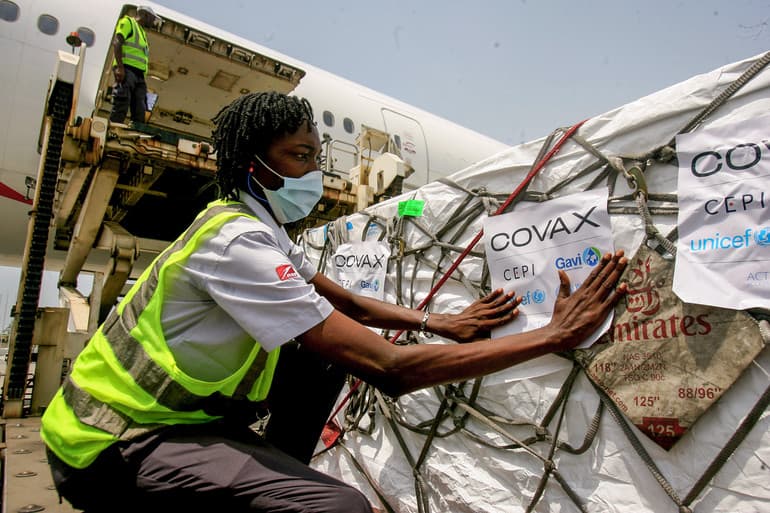
COVAX is the present-day vaccine sharing initiative to get doses to low-income countries. | Diomande Ble Blonde/AP Photo
The Gates COVAX paper made its way to U.S. health officials who briefed Azar, the then-U.S. health secretary, on the paper before a call with Gates in March 2020, according to a former senior Trump official.
“The aim is to deploy vaccines in record time (‘moonshot’),” the paper said.
Instead, though, the initiative moved slowly.
In the first several months after ACT-A’s formation, the consortium struggled to identify a clear structure — one that would allow for minimal bureaucracy and the free flow of ideas, according to three people involved in its creation.
Meanwhile, grassroots organizations fretted about their lack of inclusion in the planning. Board members of the civil society delegations wrote to the main players in ACT-A in June 2020, calling for civil society representatives to be meaningfully engaged in the consortium’s decision making process.
“Too often civil society and communities are asked their opinion too late, and as a result, initiatives lose valuable insight on implementation, demand generation, gender perspectives and launch considerations,” the letter said.
COVAX, the vaccine pillar of ACT-A, would not bring on civil society representatives — people who speak for a broader range of constituencies — officially until October 2020, months after its creation.
One EU official said the organizations — at least in the early days of ACT-A — were not transparent about their decision-making. While there were almost daily exchanges between EU officials and the organizations, the person said, there was a lack of consultation on major decisions, with not enough detail on where the donations from countries were going.
“They received huge amounts of funds and they should have been more transparent what it was used for,” the official said.
A representative for ACT-A pushed back on the idea that the consortium was not transparent in its decision-making. The representative pointed to the ACT-A website that outlines how the initiative makes decisions through a series of councils and working groups that include government officials and civil society representatives. Still, U.S. and European officials, as well as other global health advocates, said they were confused by ACT-A’s structure and could not understand its financing structure.
Founders of the WHO consortium said they designed ACT-A without a clear leader on purpose.
Peter Sands, the executive director of the Global Fund, defended ACT-A’s structure.
“There is a sort of issue that people raised, which is, there was nobody in charge. It wasn’t that it was designed like that. It was designed intentionally as a collaborative leadership model,” Sands said. “We took the view that a centralized kind of one organization trying to tell everybody else what to do wouldn’t work.”
Aylward, the lead for ACT-A at the WHO, described the structure as a “huge success,” adding that it was an intentional decision to have the agencies involved in the initiative run their own budgets, programming and donor talks in order to “get money out the door quickly as possible.
”But money did not flow to ACT-A or the agencies running the programs quickly enough to help distribute life-saving Covid tools to low-and middle-income countries.
The battle to establish systems to get vaccine doses and treatments to countries in need was just beginning — and it would take almost another year to convince wealthy Western governments to do significantly more to help.
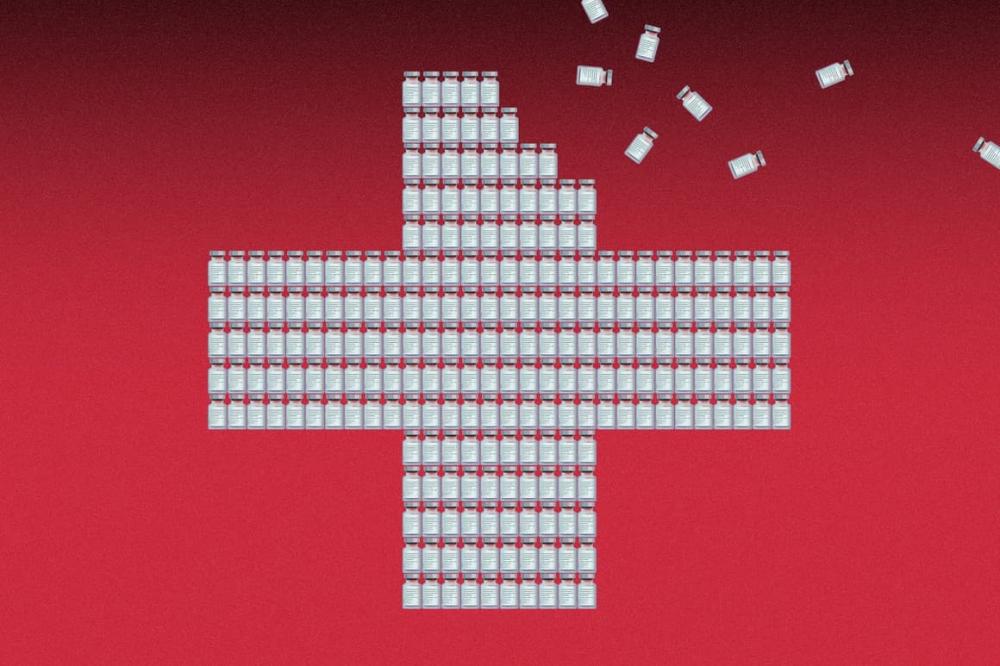
CHAPTER 2
A rush for vaccine doses
Throughout the spring and summer of 2020, the global health organizations poured money into vaccine development.
In July, CEPI announced it would donate $66 million to Clover Biopharmaceuticals to help the company through its clinical trials. CEPI, Wellcome and the Gates Foundation invested up to $449 million in Oxford University — including partnerships with the school and other companies — for vaccines. Wellcome granted $2.4 million to the Wits Health Consortium in South Africa to help with research on detecting and surveilling Covid.
Meanwhile, CEPI and the other organizations faced questions from their own boards and the global health community about equitable distribution – how to ensure that low-income countries would get a fair share of their charitable giving. How would the organization, along with its partners, convince wealthy, Western countries to help those living in low-income countries? The die seemed to be cast: In previous infectious disease outbreaks, tests, treatments and vaccines had shown up in developing countries last.
Board members raised concerns about entering into agreements with vaccine companies without fully applying equitable access provisions — provisions that would require the companies to adhere to certain rules of distribution. Only later would these provisions be put in place, according to an external review of the equitable access conditions tied to CEPI’s vaccine deals. The review found that while CEPI had a “robust commitment to equitable access” its agreements were characterized by “relatively high levels of trust between parties,” with language such as “reasonable” and “best efforts” used.
Defending the need for these initial agreements that lacked full equitable access provisions, the CEPI spokesperson said this was done “to release small sums of money, which would allow development of the vaccines to rapidly progress in the face of an impending global health emergency.”
“This happened at a time when there were no safe, effective vaccines available at all and when speed was absolutely critical,” the spokesperson said.
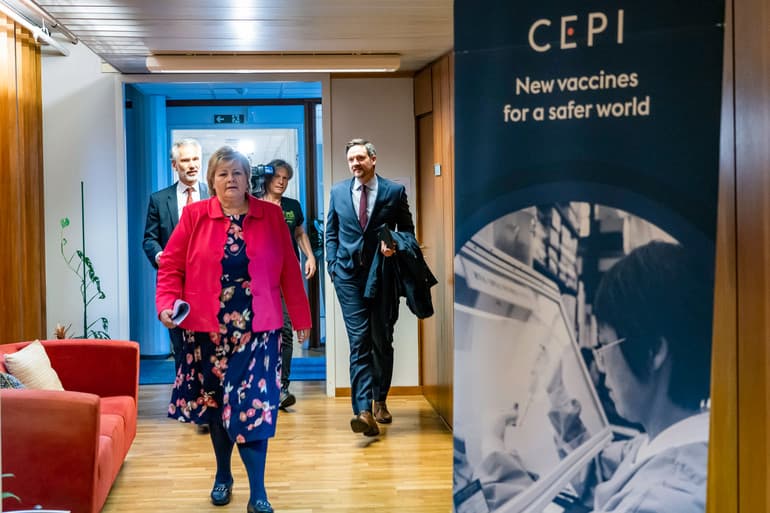
CEPI launched in 2017 with the financial backing from the Gates Foundation, the Wellcome Trust, India and Norway. Shown above, Norway Prime Minister Erna Solberg (center) with CEPI Deputy Director Frederik Kristensen (left) during a visit to CEPI's Oslo office in April 2020. | Heiko Junge/NTB Scanpix via AP
Berkley, the CEO of Gavi, said he was concerned early on in the pandemic about the extent to which Western governments would finance and donate to an operation that primarily served low- and middle-income countries. His organization and the broader COVAX initiative have been criticized by other leading global health advocates for not factoring in that reality earlier and finding a workaround.
“When it first became clear that this disease was appearing, Richard and I sat down and said, we know what happened with the last swine flu pandemic, where wealthy countries bought up all the doses that were … available for the developing world, we have to try to do something different about that,” Berkley said. “When Richard and I had that meeting, President Trump was down the street saying that there was no problem – that was going to be over quickly. So, we were a little bit swimming upstream. We had no money.”
Global health advocates, too, worried that not enough was being done to ensure low-income countries across the world had access to life-saving medicines and shots. They argued pharmaceutical companies — and the funders of their products — needed to do more to expand access to the vaccine, namely through the sharing of intellectual property.
In May 2020, the WHO issued a statement calling on industry, governments and the global health community to “pool knowledge, intellectual property.”
Doctors Without Borders supported the call to action. “Sharing this type of information will allow more manufacturers to quickly produce medical tools to fight COVID-19 and make sure more people have access to them,” the organization’s statement from that time said.
On its website, the Gates Foundation says that when it grants money, it requires its partners to adhere to its global access principles — measures that require them to make vaccine doses widely available at an affordable price. During the pandemic, the foundation pushed back publicly on pressuring pharmaceutical companies to share its intellectual property, saying doing so would do little to spur rigorous vaccine development in the short term.
In one instance, the foundation appears to have helped urge a vaccine maker to partner with a pharmaceutical company to help scale production, according to a report by Bloomberg News, which cites a call between Bill Gates and reporters. That urging led Oxford University — a longtime Gates grantee — to share its rights with just one company — AstraZeneca — rather than sticking to the university’s own guidance that any deal it makes include non-exclusive and royalty-free licensing.
In May 2020, the WHO issued a statement calling on industry, governments and the global health community to “pool knowledge, intellectual property.”
Doctors Without Borders supported the call to action. “Sharing this type of information will allow more manufacturers to quickly produce medical tools to fight COVID-19 and make sure more people have access to them,” the organization’s statement from that time said.
On its website, the Gates Foundation says that when it grants money, it requires its partners to adhere to its global access principles — measures that require them to make vaccine doses widely available at an affordable price. During the pandemic, the foundation pushed back publicly on pressuring pharmaceutical companies to share its intellectual property, saying doing so would do little to spur rigorous vaccine development in the short term.
In one instance, the foundation appears to have helped urge a vaccine maker to partner with a pharmaceutical company to help scale production, according to a report by Bloomberg News, which cites a call between Bill Gates and reporters. That urging led Oxford University — a longtime Gates grantee — to share its rights with just one company — AstraZeneca — rather than sticking to the university’s own guidance that any deal it makes include non-exclusive and royalty-free licensing.
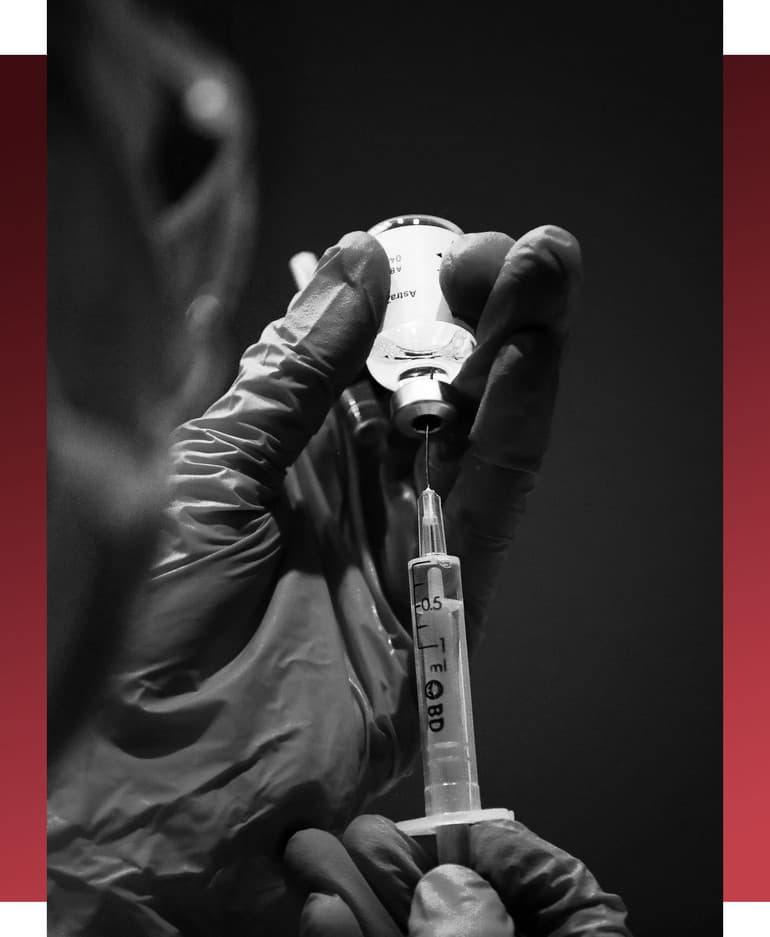
Oxford University, a longtime Gates grantee, shared its intellectual property rights with just one company — AstraZeneca. | Frank Augstein/AP Photo
When the university struck the deal, it gave AstraZeneca sole rights — a step that scientists at the university had resisted early on in the development of the vaccine, according to a report by the Wall Street Journal.
“[Bill Gates] flipped the Oxford position on open licensing,” said James Love, director of Knowledge Ecology International, a non-governmental organization that focuses on intellectual property, who played a key role in negotiations around generic HIV treatments in the early 2000s. “He had access to heads of state. He had outsized influence on CEPI and Gavi.”
The Gates Foundation pushed back against that assertion, saying the foundation did not tell Oxford University to go exclusively with AstraZeneca and had no role in those negotiations. The spokesperson for CEPI said the organization’s “policy on and approach towards intellectual property ownership is independent.”
“We discussed with the University of Oxford the importance of aligning with a multinational company to ensure their researchers have the full range of capabilities and resources they need to bring their vaccine candidate to the world,” said Trevor Mundel, president of the global health program at the Gates Foundation.
Soon after the announcement of the deal, CEPI and Gavi revealed plans to give $750 million to AstraZeneca to secure 300 million doses for COVAX. AstraZeneca also reported reaching a deal with the Serum Institute of India — an institute that received significant funding from the Gates Foundation — to supply one billion doses to low- and middle-income countries.
Gavi launched the COVAX Facility — a project to pool procurement for doses that the COVAX effort could then deliver to low- and middle-income countries at an affordable price — in June, 2020. It would go on to sign two additional advance purchase agreements with some of the first vaccines on the market, including Pfizer.
Scaling up
The U.S. officially launched Operation Warp Speed on May 15. By the summer it began expanding its vaccine development portfolio, investing $1.6 billion in Novavax’s manufacturing and an initial $1.95 billion to Pfizer for the large-scale manufacturing and nationwide distribution of 100 million doses. It pledged $2.1 billion to support the development of Sanofi and GSK’s vaccine.
In an effort to scale production to provide equitable access to low-income countries, representatives from the Gates Foundation pushed U.S. officials to share the immune correlates of protection from Covid vaccines — immune markers that can help other institutions develop their own vaccine products, according to an individual with direct knowledge of the situation.
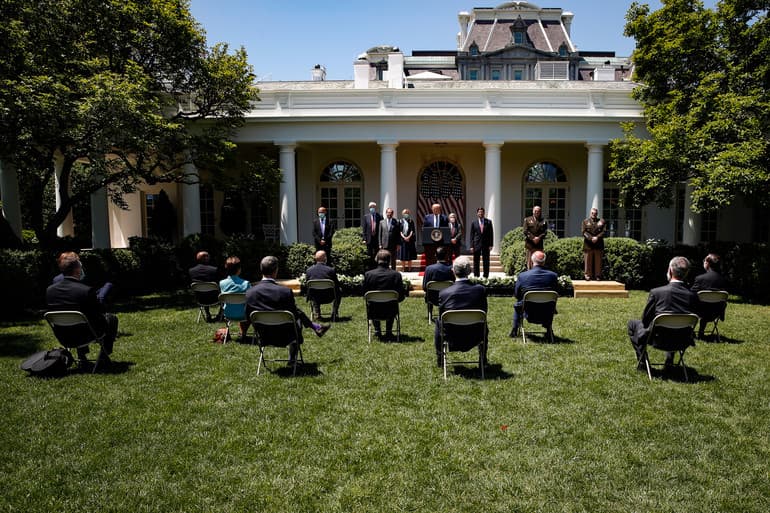
Trump announced the official launch of Operation Warp Speed during an event at the White House on May 15, 2020. | Alex Brandon/AP Photo
The Gates Foundation had granted money to organizations working on Covid vaccine development across the world that were in need of the correlates to help develop the shots.
If shared, the immune correlates of protection can help the company establish efficacy without going through an efficacy trial — one that can take months to complete. U.S. officials agreed and NIH eventually published the correlates in 2021.
By August 2020, representatives of the Gates Foundation, CEPI, Gavi and Wellcome also began to raise questions about whether the U.S. would share doses with the rest of the world. Representatives from the foundation, including Bill Gates himself, would go on to conduct several meetings with senior European officials to discuss commitments to ensure equitable access to vaccines.
Emilio Emini, then one of the leaders working on HIV and tuberculosis at the foundation, spoke with U.S. officials at Operation Warp Speed about U.S. vaccine investments, according to two former U.S. officials and people who worked on the government’s Covid vaccine projects. Emini would later go on to work with the Biden administration on vaccine distribution.
But no commitment to equitable distribution was forthcoming.
“The position that the administration was having was to say, ‘let’s not spend a lot of time discussing what we do with the vaccine doses because the key is to first have vaccine doses.’ We will get vaccines that work and then we’ll address that problem,” a person with direct knowledge of the situation said.
A promise of equity
By September 2020, nearly 1 million people across the world had died of Covid and governments were counting the days until the vaccine came online.
At least four pharmaceutical companies were in or moving into the third phase of their clinical trials and officials in the U.S. and Europe were growing more confident that the world would see its first vaccine dose come to market by the turn of the year.
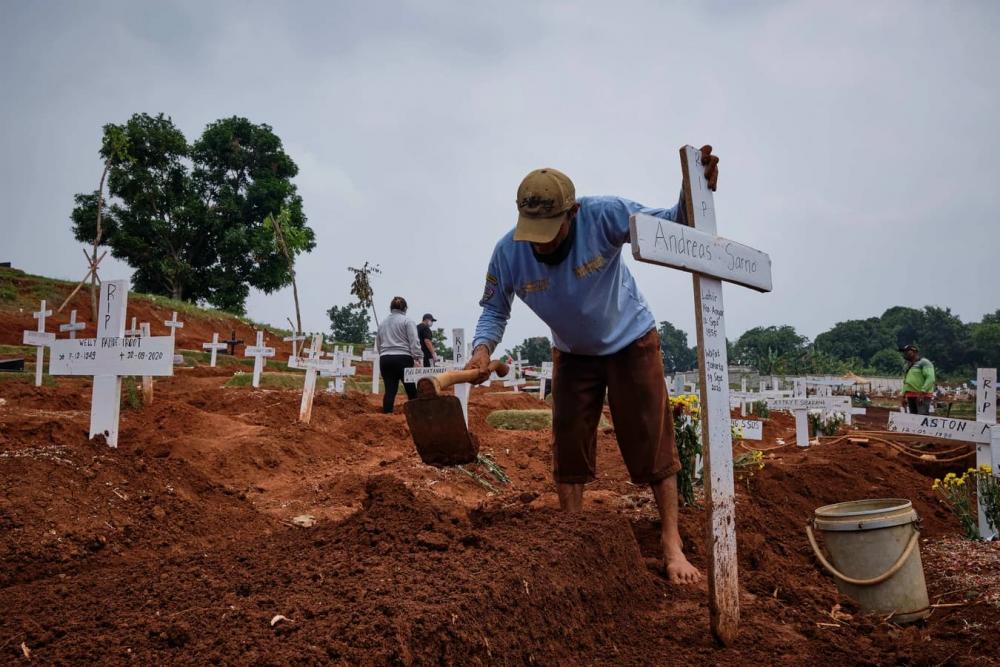
By September 2020, nearly 1 million people across the world had died of Covid. | Ed Wray/Getty Images
But within the top ranks of the four organizations and ACT-A, there was only anxiety. The virus was continuing to spread rapidly across the world, and poor countries were being left behind.
On Sept. 10, 2020, representatives of the four global health organizations, including Melinda French Gates, appeared at the first official meeting of ACT-A — five months after its creation. The event marked the official push by the consortium to begin ramping up donation campaigns and pressing governments to build out their international responses to the virus. ACT-A’s finance committee, made up of government officials and leaders of the agencies, called for a total of $38 billion to be donated to the agencies involved in the initiative, including CEPI and Gavi.
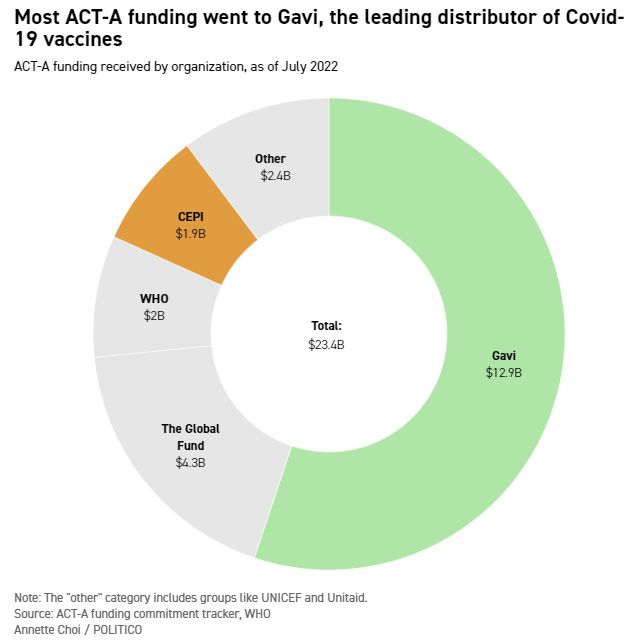
Gavi, in coordination with the WHO, CEPI and UNICEF, took the lead in setting up a pooled procurement and financing mechanism for COVAX — a mechanism that, for example, helped low-income countries secure the Serum Institute’s AstraZeneca doses at $3 per dose. Wellcome helped finance the therapeutics pillar. Several other organizations helped fund and lead the diagnostics and health systems pillars of ACT-A. Meanwhile, the Gates Foundation financed the development of both vaccines and treatments through commitments to Gavi, according to the POLITICO-WELT financial analysis.
In WHO readouts from ACT-A facilitation council meetings in the fall of 2020, the consortium announced internally that it had struck deals to make more than 120 million Covid tests available to low-income countries for $5 per unit. The Gates Foundation, through two separate volume guarantees, helped finance the deal with SD Biosensor and Abbott. The agreement marked one of the first major wins for the WHO consortium.
But as the ACT-A fundraising began to grow in strength over the course of the fall of 2020, representatives from civil society and health advocates in the broader global health community began to raise questions about the inner workings of the consortium and how decisions were being made.
For example, it was unclear to outside global health observers how much ACT-A’s partner agencies were receiving from those fundraising efforts and how they were using the money to strike deals with the pharmaceutical industry — a potential inefficiency, if price controls were not in place, or conflict of interest.
“We don’t have democratic accountability mechanisms that allow us to scrutinize those interactions,” said Katerini Storeng, associate professor at the University of Oslo’s Centre for Development and the Environment, and head of a research project on public-private partnerships for pandemic preparedness. “A lot of them [ACT-A meetings] are not formal meetings. … We have struggled to gain access to the documents and the correspondence… [that would have made it] possible to scrutinize how decision-making processes have actually happened, and to establish whether they have been subject to democratic control.”
Representatives who worked with ACT-A at the WHO say the initiative was never supposed to resemble a formal organization or legal entity, rather a loose structure that allowed the groups to scale production of tests, treatments and vaccine at the same time. So, given the urgency of the situation, there weren’t a lot of checks and balances.
“ACT-Accelerator has been set up as a light and simple support structure,” ACT-A’s first update from September 2020 said. “Some of this … needs to be in the form of constructive criticism and learning rather than sort of trying to blame people. There was a lot of real time problem solving in an extremely uncertain environment,” said Sands, the executive director of the Global Fund.
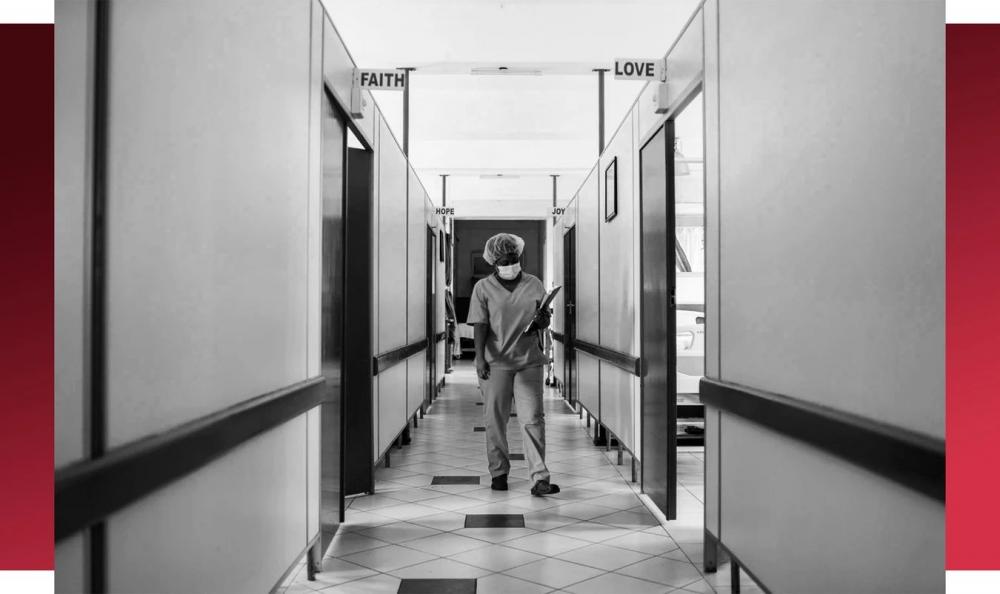
The take-care-of-your-own ethos in wealthier countries effectively drained money from the global fight against Covid. | KB Mpofu/Getty Images
The four organizations promised — both through their grants and investments as well as through the formation of ACT-A — to strive to give everyone in the world, no matter where they lived, equal access to life-saving medicines and shots. But as the pandemic began to unravel economies, killing millions, Western countries retreated even further inward to manage the health crisis, dedicating resources to national efforts rather than the fight against the virus abroad.
The take-care-of-your-own ethos in wealthier countries effectively drained money from the global fight against Covid, and arguably served to misallocate resources, since the virus knew no national boundaries. It also gave non-governmental organizations funding the effort unusual sway over policy.
“There is a flaw in the design of global health,” said a top German health official. “That flaw is that these philanthropists are needed to improve global health. Lots of things work thanks to them, but some don’t.”
By October of 2020, the U.S. had shown few signs that it was willing to scale its international response to Covid. It had committed minimal resources to the global response.
The Centers for Disease Control and Prevention was one of the few U.S. agencies working to help low-income countries abroad fight the virus. In comparison, European Union member countries, together with the European Commission and the region’s investment bank, had pledged over €11 billion for vaccines, tests, treatments and economic recovery in poorer countries. And the Gates Foundation had granted more than $402 million to various organizations to fight Covid.
By that same time, Wellcome had granted $29.3 million on things like Covid data modeling, infection control, as well as research studies on vaccines and therapeutics. And Gavi, together with the Gates Foundation, signed a deal for another 100 million vaccine doses from the Serum Institute, bringing the total to 200 million. The foundation put up $300 million for the partnership that was meant to provide doses for both India and other low- and middle-income countries.
But this plan, too, fell victim to national concerns. The Serum Institute, based in India, would a year later halt all exports to COVAX during the country’s summer surge that killed millions of people. That disruption would set COVAX deliveries back by months.
A push for donations
In the lead-up to the U.S. election in November 2020, President Donald Trump’s efforts to downplay the severity of the Covid threat ran up against the fact that the president himself had contracted it and more than 220,000 people in the country had died. In Europe, cases surged. In Switzerland, ICU beds were at capacity in November, with the situation being described as “critical.” Italy’s death numbers soared into the 700s per day — higher than at any time since April 2020.
As numbers continued to spike across the globe, the four organizations tried to lock down a clear international allocation mechanism for tests, treatments and vaccine doses.
But by November 2020, ACT-A still faced a significant financial gap. It only had $10 billion in the bank.
“Urgent and stronger political support and full financing of the ACT-Accelerator is needed,” according to a WHO summary of an ACT-A facilitation council meeting that month.
A COVAX report from November 2020, said COVAX intended to provide access to at least 2 billion doses to low- and middle-income countries by the end of 2021. By the end of that month, WHO said COVAX had raised $2 billion — enough to help it secure 1 billion doses. But COVAX would need another $5 billion to reach its target by the end of 2021, the WHO said at the time.
Leaders of COVAX, including those at Gavi, continued to try to procure doses on the open market, but limited manufacturing capacity blunted progress. Western countries had already placed orders, eating into the manufacturing schedule.
“It didn’t take a rocket scientist to foresee that a global mechanism was going to be very quickly butchered by the reality of high-income countries that are just going to pursue their own individual agendas first,” said Elder, the senior vaccine policy adviser at Doctors Without Borders.
Berkley said COVAX included high-income countries in its original calculation for dose-sharing with the hope that their inclusion would get them “more interested in supplying developing countries.” But that didn’t end up happening until much later — toward the middle of 2021.
Meanwhile, in Africa, members of the African Union and the Africa Centers for Disease Control and Prevention launched a different initiative to procure and deliver doses on the continent. They created the effort, dubbed the African Vaccine Acquisition Task Team, to ensure that the people of Africa would have access to vaccine doses. African leaders were beginning to show signs that they did not have confidence in COVAX.
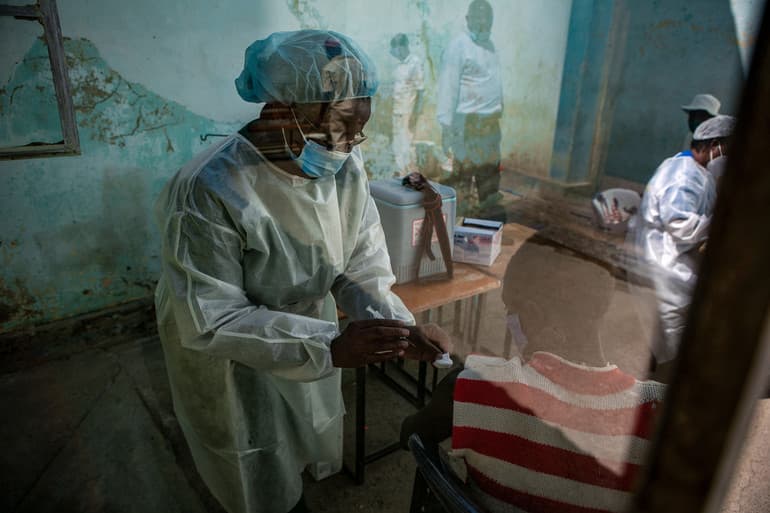
African leaders, in response to losing confidence in COVAX, developed their own vaccine initiative. Shown above, an inmate receives a Covid vaccine in Harare, Zimbabwe. | Tafadzwa Ufumeli/Getty Images
“This was a deliberate global architecture of unfairness,” Strive Masiyiwa, who helped secure doses for the African Union, said at a summit the following year, speaking about vaccine inequity. “Imagine we live in a village, and there is a drought. There is not going to be enough bread, and the richest guys grab the baker and they take control of the production of bread and we all have to go to those guys and have to ask them for a loaf of bread: That is the architecture that is in place.”
Beyond the concerns regarding funding, civil society organizations and other health advocates also grew increasingly frustrated that the unelected leaders of these global health organizations — mostly men from Western countries — did little to include other actors, including representatives from the low-income countries they were trying to help.
One senior U.S. official equated the leaders to a “cabal.”
“It’s just the same people calling the same people every time there is an outbreak,” one current senior U.S. official said. “There’s very little diversity.”
All four organizations pushed back on this assertion, saying they regularly engage with civil society representatives and officials from low-income countries they work to serve.
Masiyiwa, the vaccine procurer for the African Union, joined the board of the Gates Foundation in 2022.
A new lobbying push
Throughout the fall of 2020, the Gates Foundation and representatives from CEPI, Gavi and Wellcome ramped up their lobbying and advocacy efforts.
Bill Gates, Farrar, Berkley and Hatchett all spoke with U.S. officials and lawmakers to garner their support for COVAX, ACT-A and donating vaccine doses abroad, according to two former senior U.S. officials.
In the last quarter of 2020, CEPI and Gavi collectively spent more than $100,000 on lobbying in the U.S. in part to help finance the organizations’ Covid operations, according to lobbying disclosure forms. CEPI requested lawmaker support for $200 million annually from USAID, the disclosures said. The organization’s representatives also met several times with senior USAID officials to develop a way for the agency to support CEPI financially, according to a former senior Trump health official. Gavi spent about tens of thousands of dollars lobbying Congress and officials at USAID for similar reasons.
In Europe, internal government meeting schedules show Ursula von der Leyen, the European Commission president, met with Bill Gates in November to discuss increasing manufacturing in Africa. In the fall and winter of 2020, CEPI, the Wellcome Trust and the Gates Foundation also held seven meetings with senior European Commission officials. In the U.K., Gates and representatives from the pharmaceutical industry, including Pfizer and Johnson & Johnson, met with Prime Minister Boris Johnson about the need to increase capacity and supply of treatments and vaccines worldwide.
The Gates Foundation hired Eurasia Group, a consultancy led by Ian Bremmer, a U.S. political scientist, to write several papers addressing European governments on the need for a global approach to fighting Covid. In one of the papers, the group said that Germany’s “share of funding for the ACT-A program would more than pay for itself.” Tobias Kahler, head of the foundation’s Germany, Europe, Middle East and East Asia team, circulated the papers, appealing to German officials to pledge more money to ACT-A efforts.
The lobbying efforts seemed to work.
In February 2021, then-German Finance Minister Olaf Scholz promised €1.5 billion additional for COVAX.
The European Union announced in November that it would contribute an additional €100 million in grant funding to support the COVAX Facility to secure access to the future Covid-19 vaccines for low- and middle-income countries. The pledges complemented the original €400 million in guarantees the EU committed for COVAX earlier in the year.
And in December, the U.S. Congress approved a $4 billion commitment to Gavi through an emergency funding bill.
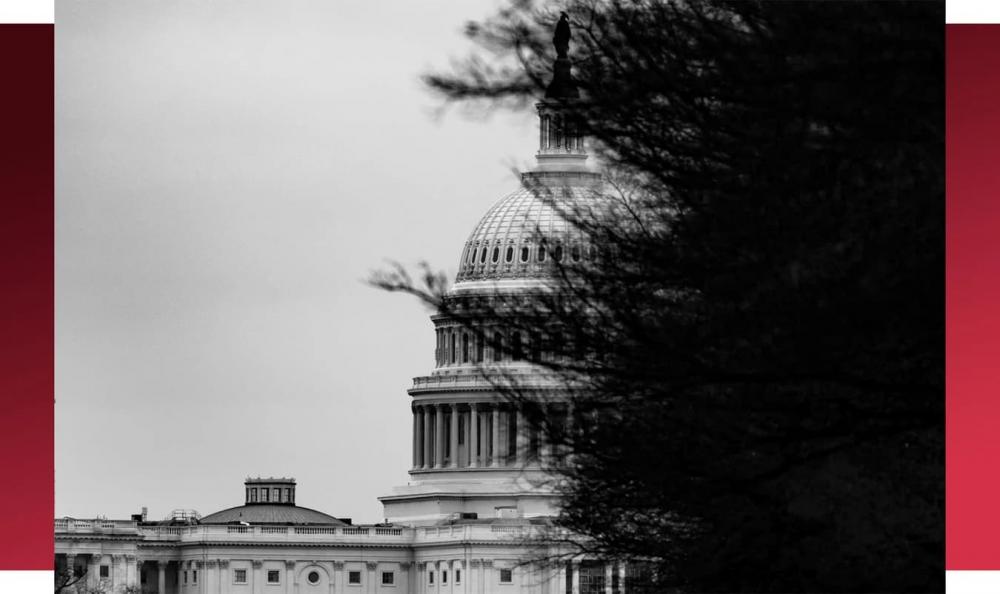
In response to intense lobbying, Congress approved $4 billion in funding for Gavi through an emergency funding bill in December 2020. | Samuel Corum/Getty Images
Despite the new commitments to Gavi at the end of 2020, ACT-A said it needed $4 billion immediately and an additional $23 billion in 2021 to help end the pandemic, according to a report its facilitation council put out that month.
Meanwhile, in the U.S., officials from the health department and the National Security Council began drafting a list of countries that would eventually receive American-made vaccine doses, according to two former senior U.S. officials. They established running lists of both U.S. allies as well as countries that couldn’t afford the vaccine and needed help procuring doses or who had helped invest in vaccine development.
But Trump White House officials and leaders of Operation Warp Speed resisted calls from inside the administration’s health community to begin brokering deals with other countries for shipments, arguing Americans needed them first, one of the former U.S. officials said.
Vaccines come online
Covid doses began rolling out en masse in the U.S. and across Europe in January 2021. Immunocompromised adults and the elderly were first in line.
By February, the U.K. celebrated administering 15 million doses. But other parts of Europe, particularly in Eastern Europe, had yet to administer any doses.
The crisis roiled the region as European officials faced accusations that the European Medicines Agency had taken too long to approve the Pfizer, Moderna and AstraZeneca shots. The U.S. had brokered meaningful relationships with pharmaceutical companies through Operation Warp Speed. Europe, however, was slow to establish similar connections, making it nearly impossible for European officials to deliver on their distribution promises. By the end of March, only 11 percent of Germans had received their first dose.
Although the vaccination campaign was just getting underway, the Gates Foundation was already trying to prepare politicians for coming pandemics. In an annual letter to German Chancellor Angela Merkel, Bill Gates and Melinda French Gates wrote: “It is not too soon to start thinking about the next pandemic.” The letter advocates increasing investment in R&D, calling organizations like CEPI “invaluable.”
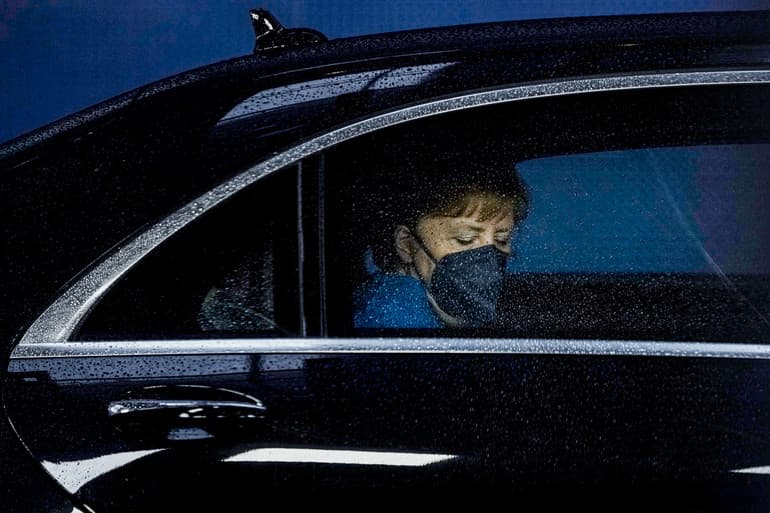
CEPI and Gavi sent numerous letters to the German chancellor’s office over a two-year period in an effort to elicit more funding for their respective organizations. | Pool Photo by Francisco Seco
If the vaccine rollouts across Europe were slow, they were essentially non-existent in low-income countries — especially in some African nations, particularly those in sub-Saharan Africa. In the first week in January, deaths on the continent rose by 50 percent from the two weeks prior, with cases in South Africa accounting for the majority, according to data published by the Africa CDC.
It wasn’t until almost three months after people in the U.S. and EU received their first doses that Africa administered its first shot on March 1, 2021. Armed with the first shipments, Côte d’Ivoire and Ghana doled out their first doses. Officials in Ghana said in interviews that the bulk of the first tranche went to health care workers and people who were immunocompromised.
Still, COVAX was unable to secure enough doses to deliver to vulnerable populations in low-income countries. There was no additional manufacturing capacity that would allow for the production of at-cost doses.
Representatives of the four organizations urged Western countries to begin thinking about donating doses to COVAX.
“That was not part of the COVAX idea, originally, because we don’t believe that a pandemic should be dealt with through donations. We believe there ought to be orders and plans for countries and a diversity of doses,” Berkley said. “One of the problems is we couldn’t get doses at that point. And so we opened up for donations. That was complicated.”

CHAPTER 3
Promises unkept
While people in the U.S. and Europe lined up to receive shots, believing that the worst of Covid would soon be behind them, African nations struggled to contain the spread.
At a series of meetings at the WTO in the spring of 2021, the sense of imbalance was so strong that officials from across the world debated whether to implement an intellectual property waiver for Covid vaccine so low-income countries could begin developing the shots on their own.
The U.S. and the European Union pushed back against the waiver, frustrating health advocates who viewed the move as indicative of their close alignment with the pharmaceutical industry.
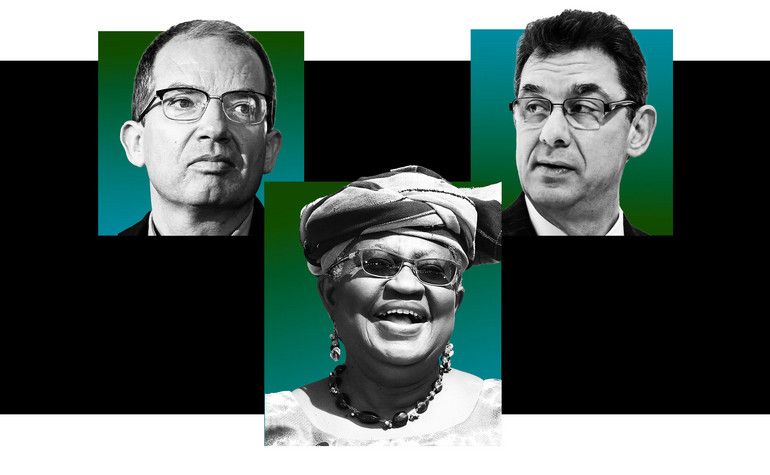
(Left to right) Moderna CEO Stéphane Bancel, WTO Director General Ngozi Okonjo-Iweala and Pfizer CEO Albert Bourla. | Getty Images and AP Photos
African officials publicly voiced concerns about the lack of distribution on the continent, fearful that they would need to jockey diplomatically for donations in order to protect their people. Others expressed dismay that massive pharmaceutical companies had refused to share their intellectual property and technical know-how with low-income countries — a step many argued would help with production in Africa.
“The fact is that each additional day the vaccine shortage continues, people will pay with their lives,” WTO Director General Ngozi Okonjo-Iweala declared at a March 2021 WTO meeting between representatives of the U.K.-based Chatham House, a think tank, and leaders from the manufacturing industry. She called on vaccine manufacturers to ramp up production in developing countries.
The pharmaceutical industry and some leading global health institutions had long pushed back against waiving intellectual property protections, arguing it would do little to scale manufacturing, particularly in the case of Covid. One former senior Trump official who worked on the U.S. response to Covid agreed with that contention, calling the argument for intellectual property sharing “bullshit.”
“The idea that these African countries had the capacity to manufacture on their own — even with the intellectual property waivers — is naive,” the former official said.
For other health advocates, the sharing of intellectual property and technical know-how was seen as a chance to provide a dramatic boost in self-sufficiency for traditionally excluded countries, one that would carry over into the next crisis.
“You’ve had this critical moment with Covid-19 like you had with the AIDS crisis, where there could be a moment where we can say … the current system of patents and access to medicines is unfair. This could be an opportunity for us to change this,” said Harman, the professor of international politics at Queen Mary University of London. “Instead … you’ve seen these institutions like Gavi, with the backing of the EU, and the U.K. government … switching and saying, what we’ll do is we’ll just create this very convoluted model that doesn’t work.”
The WHO, which publicly advocated for intellectual property waivers for Covid treatments, tests and vaccines, attempted to introduce measures that would provide a temporary solution for the lack of vaccine distribution in low- and middle-income countries. However, none of them solved the immediate access problem.
For example, in May of 2020, the WHO created the COVID-19 Technology Access Pool, also known as C-TAP, a mechanism that would allow pharmaceutical companies to share both their intellectual property and how to produce their Covid products. The Medicines Patent Pool, an organization that facilitates voluntary licensing and pooling drug patents, implemented similar mechanisms for HIV drugs, and was supposed to play a key role in facilitating the licensing deals.
But, Love said, the Gates Foundation pushed for C-TAP not to include vaccines. Another person familiar with the C-TAP discussions confirmed that view.
“C-TAP and Medicines Patent Pool were told to stay away from vaccines in 2020,” he said.
The argument from the foundation, according to the person familiar: Intellectual property wasn’t a concern in relation to vaccines and as such vaccines didn’t need to be part of the new mechanism.
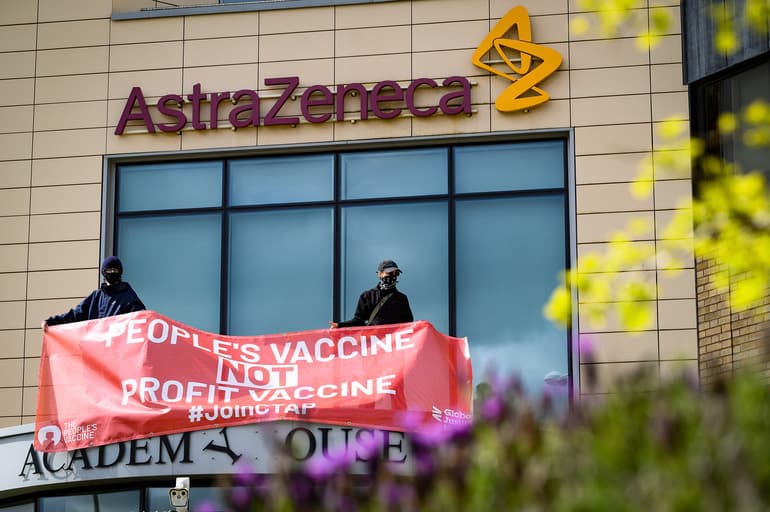

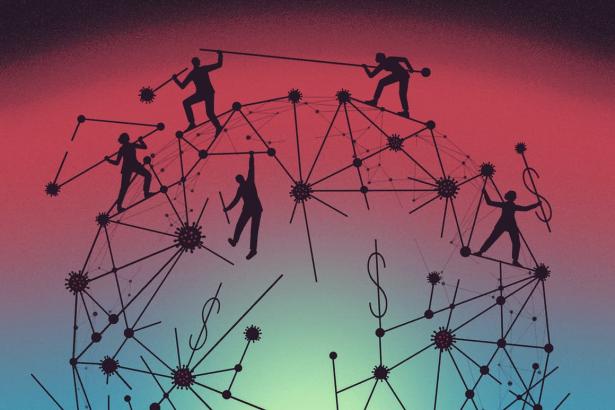
Spread the word